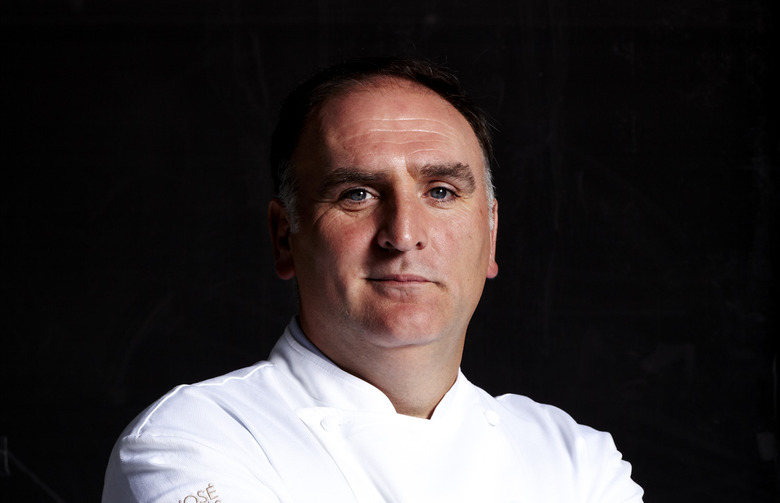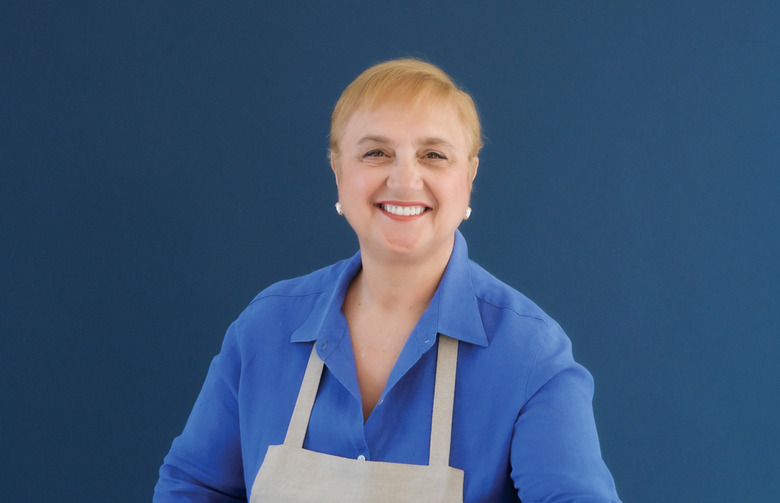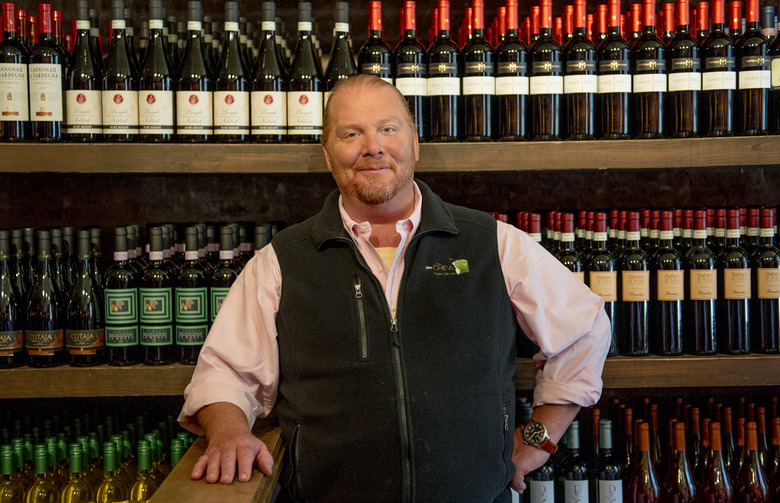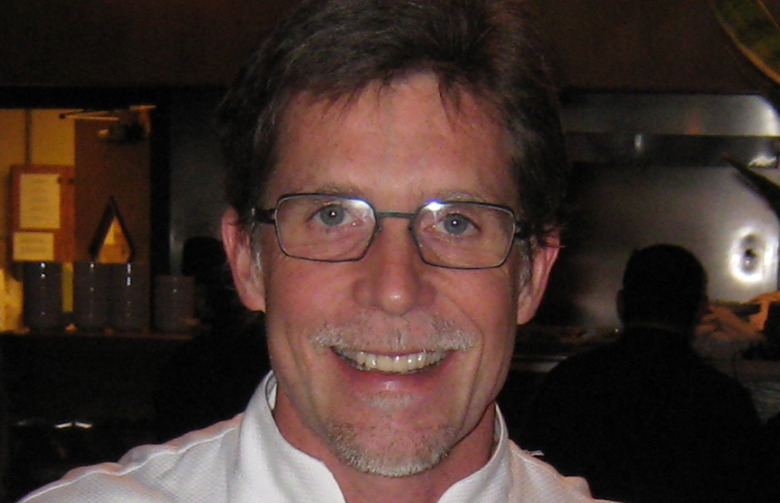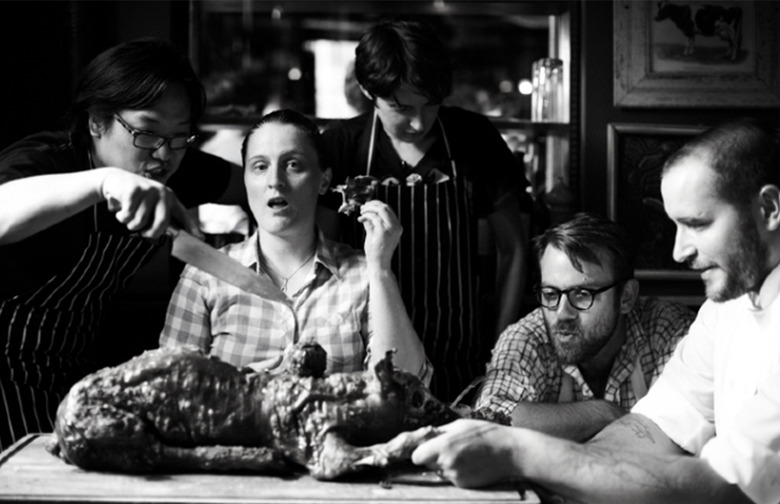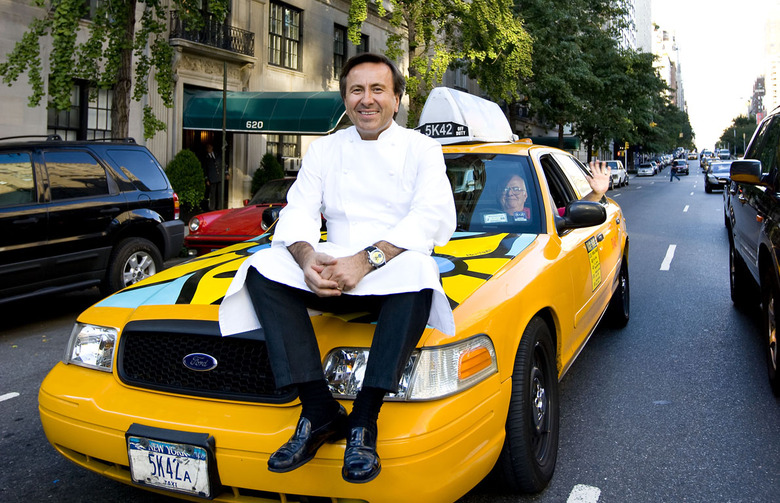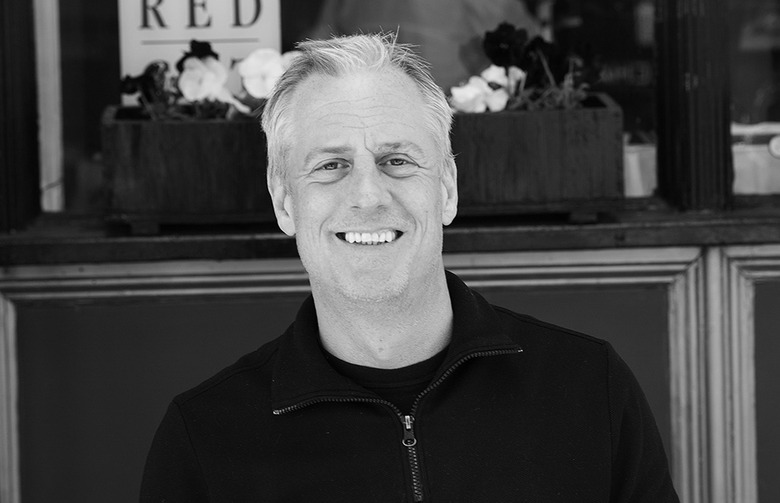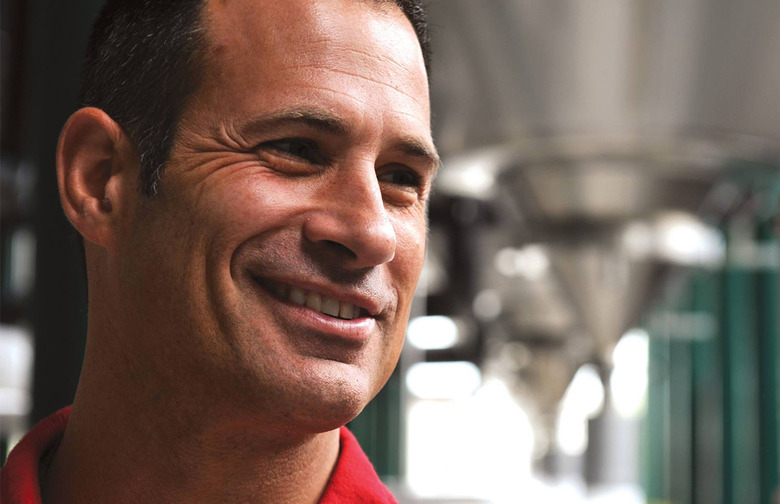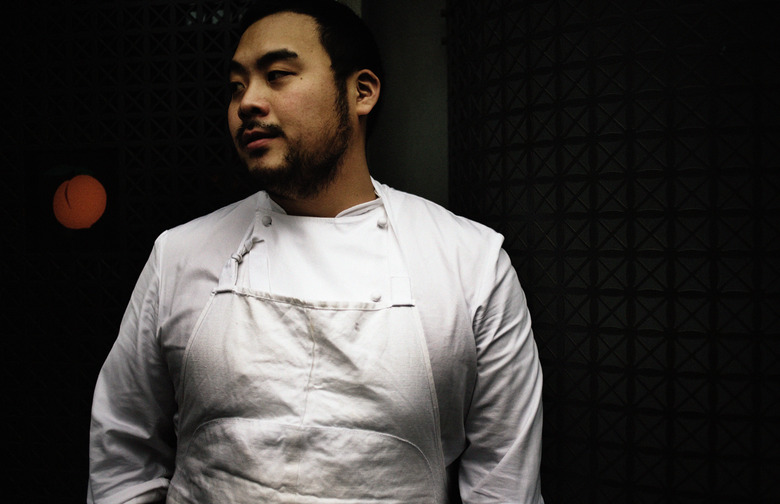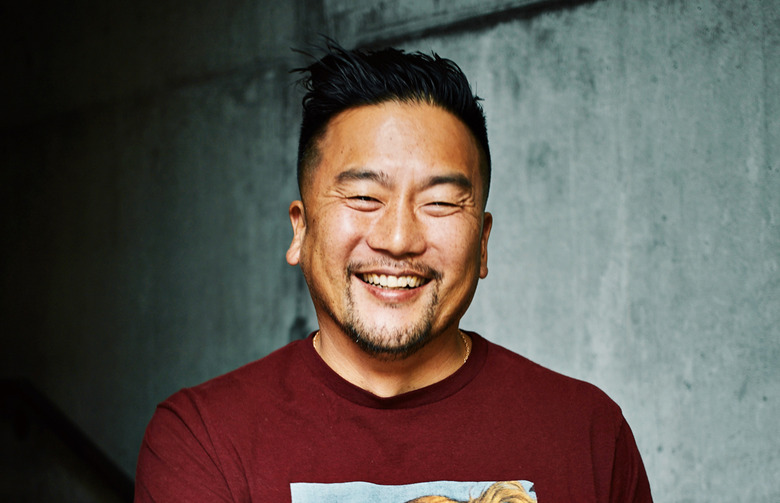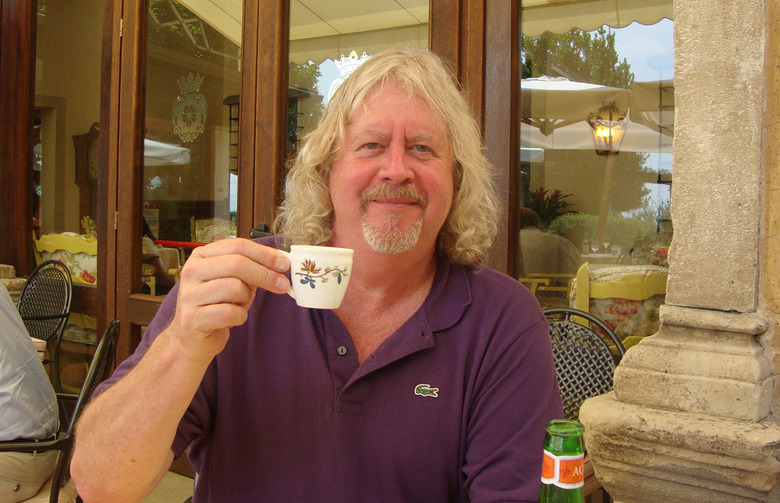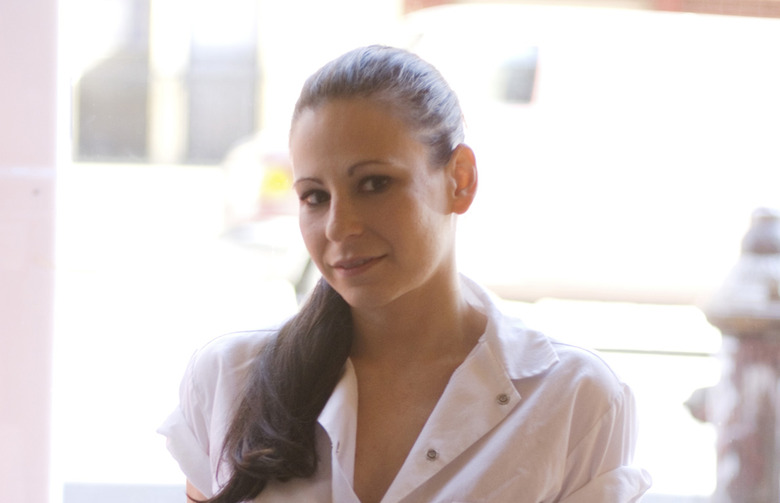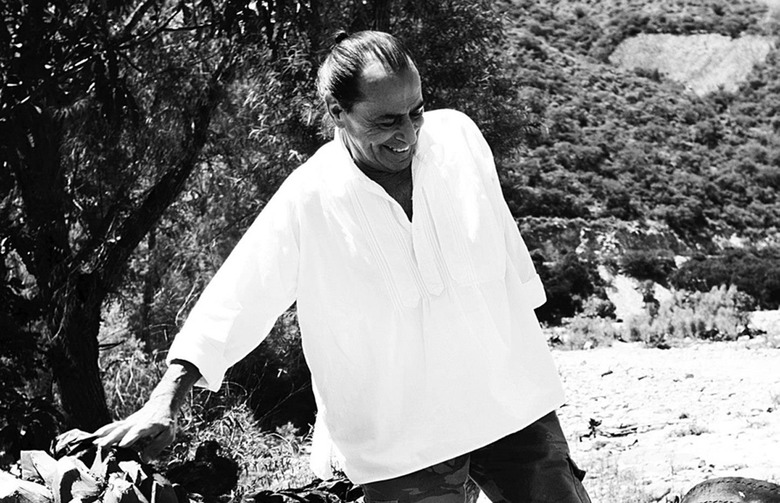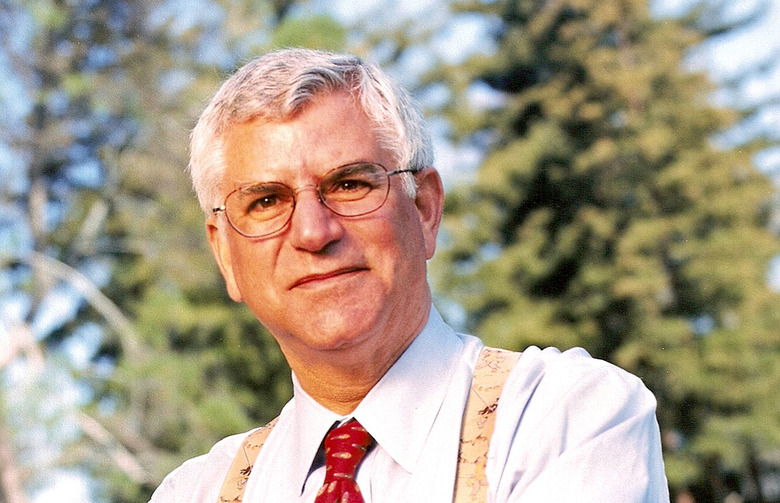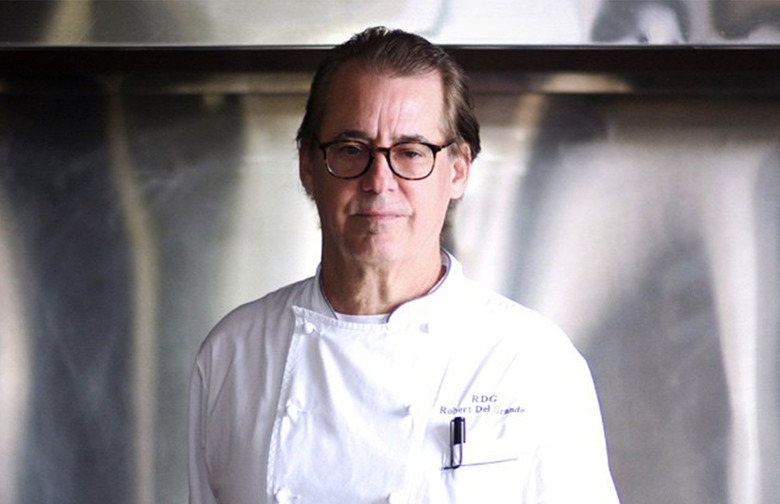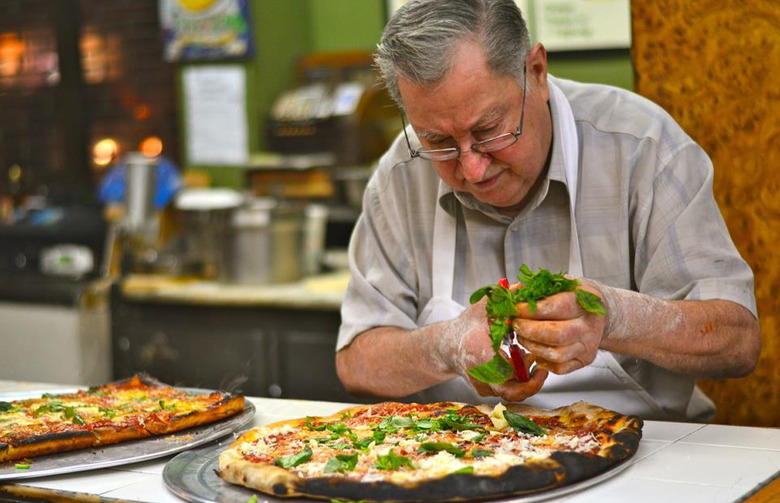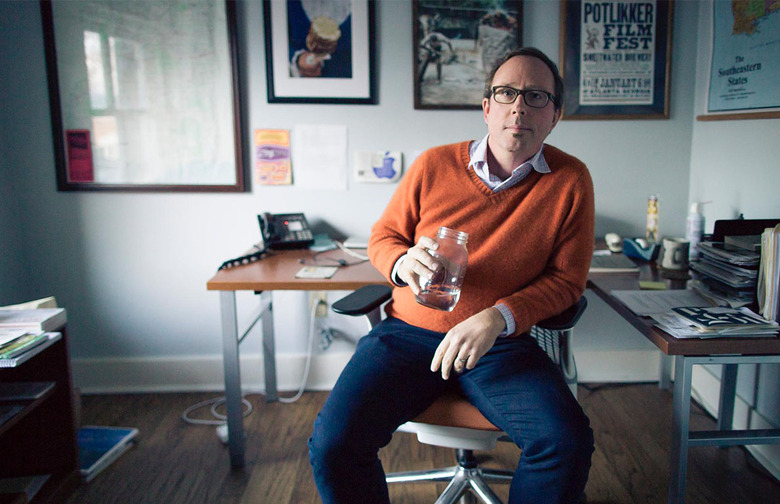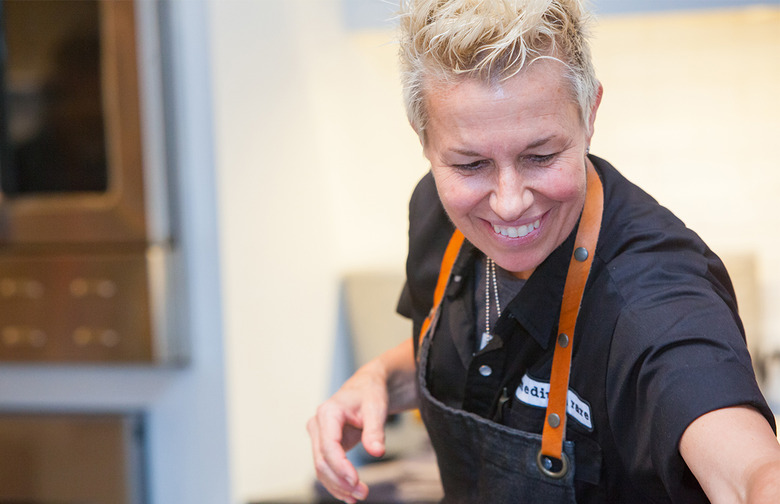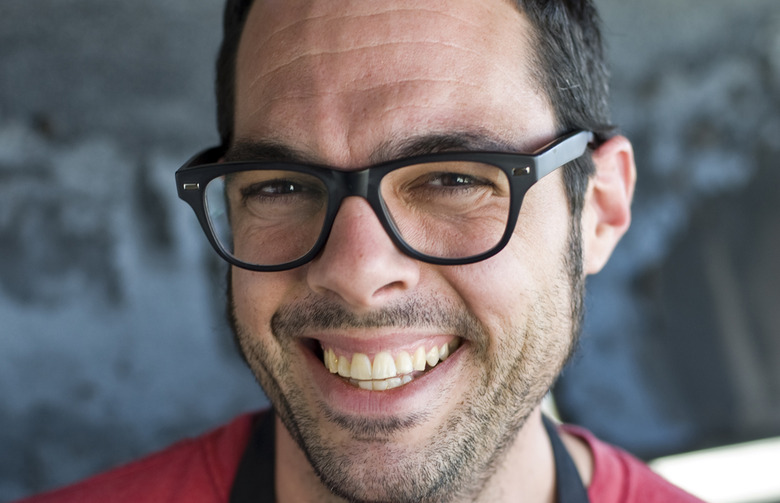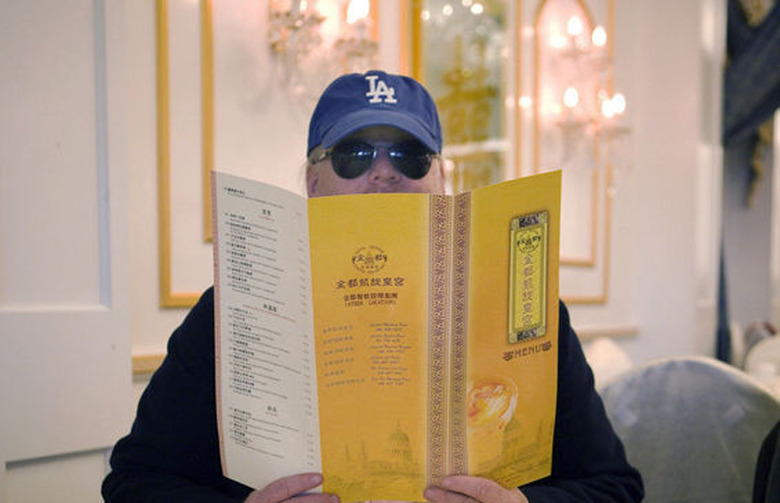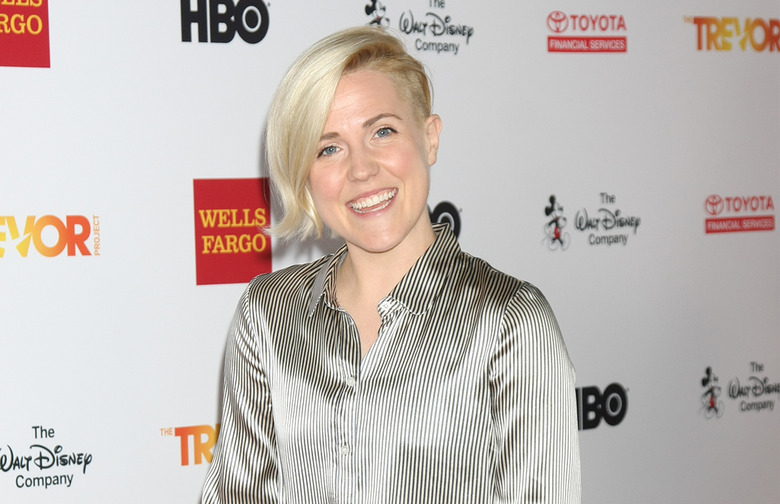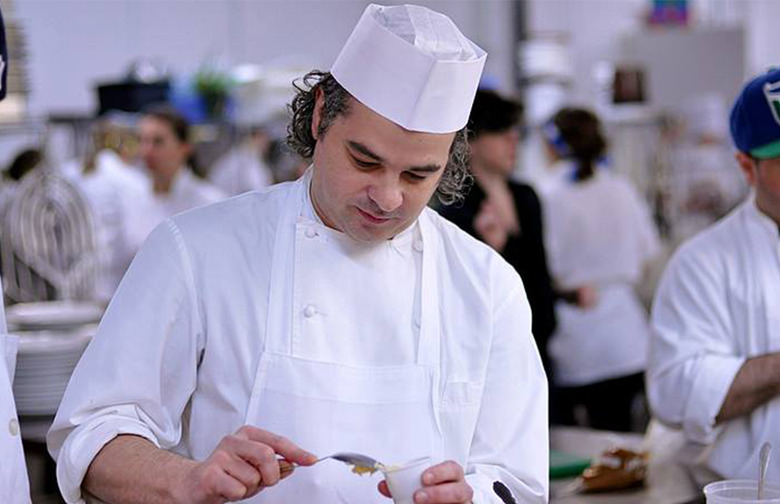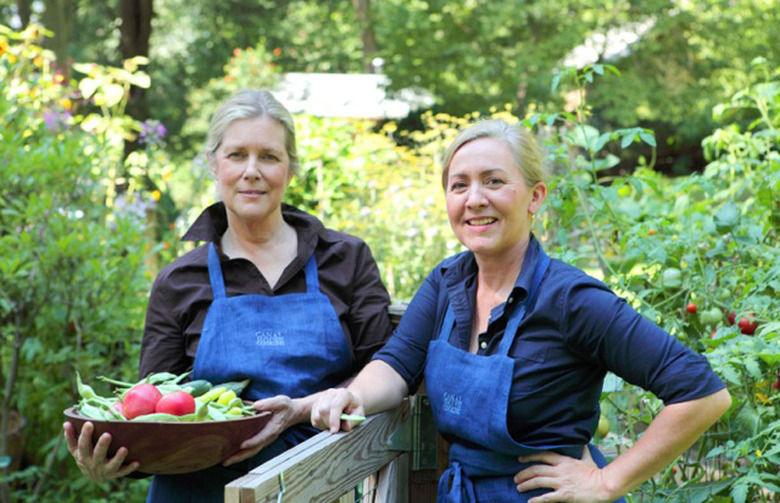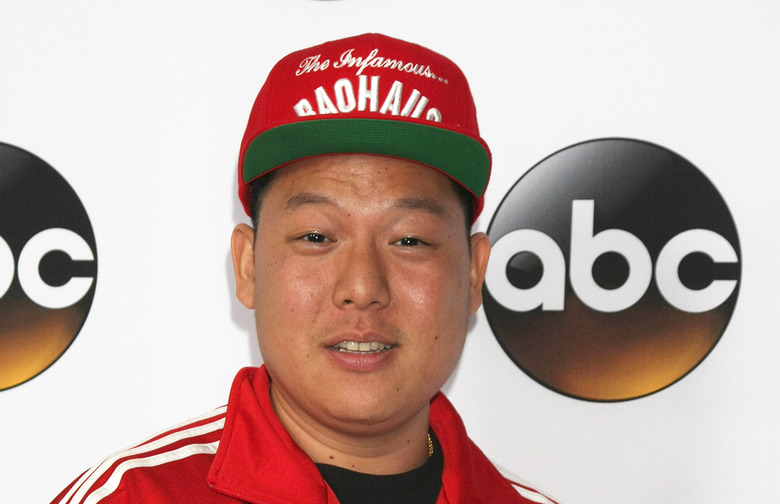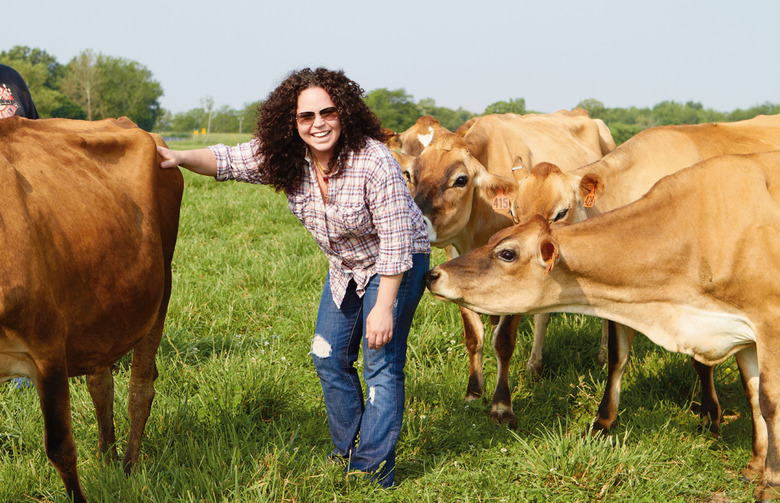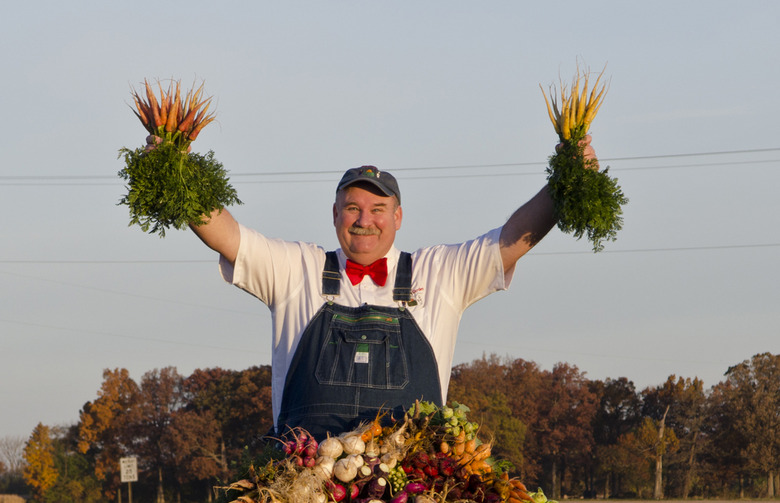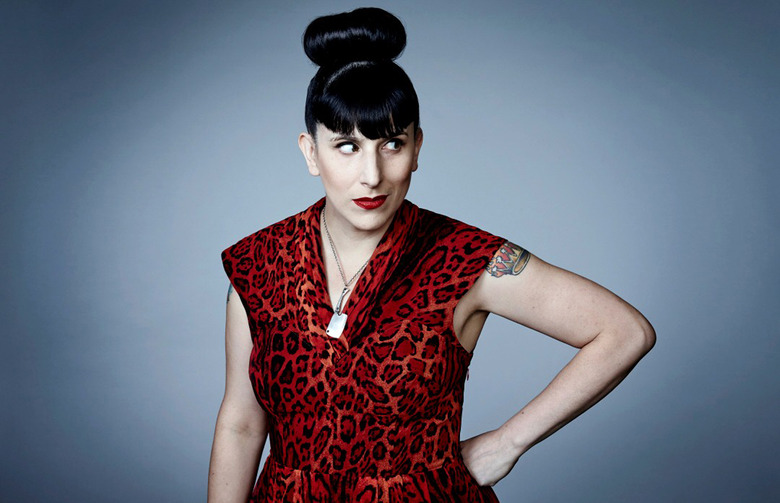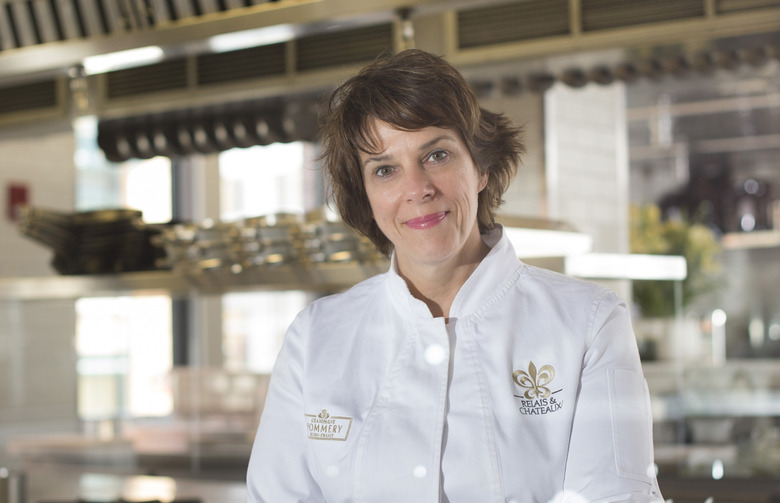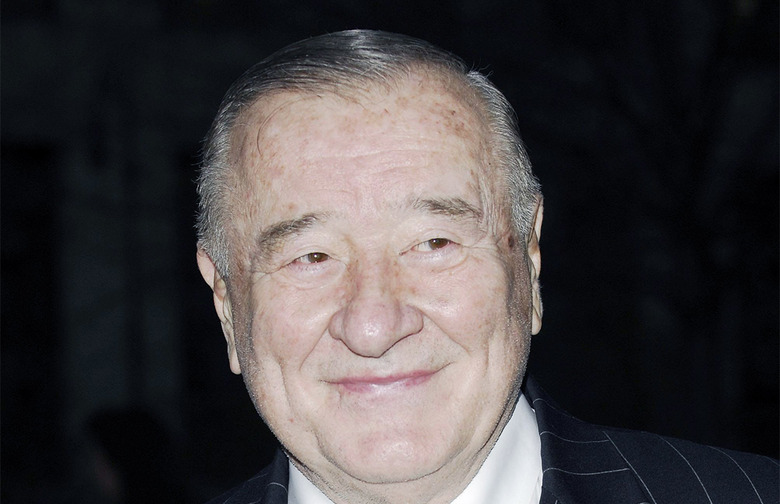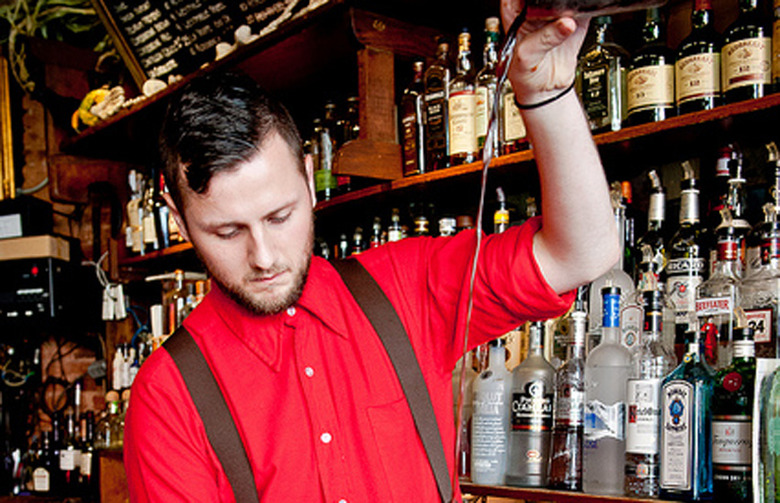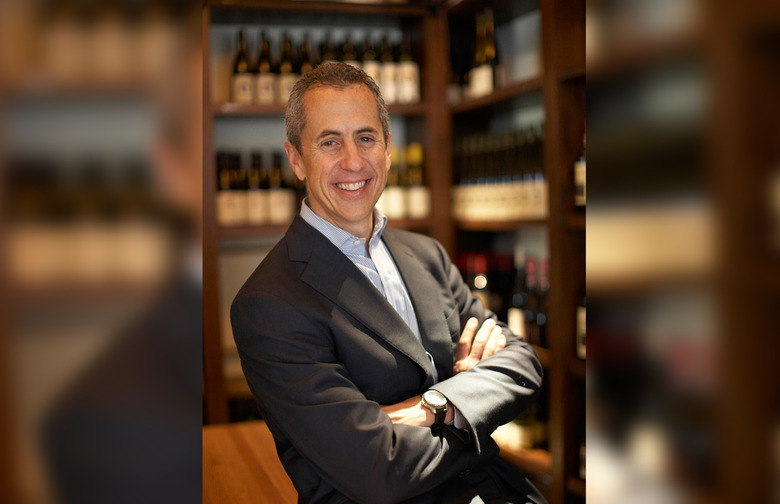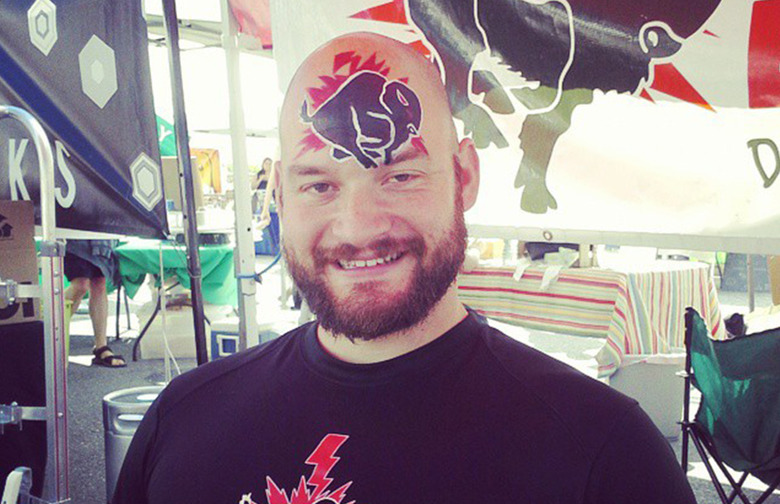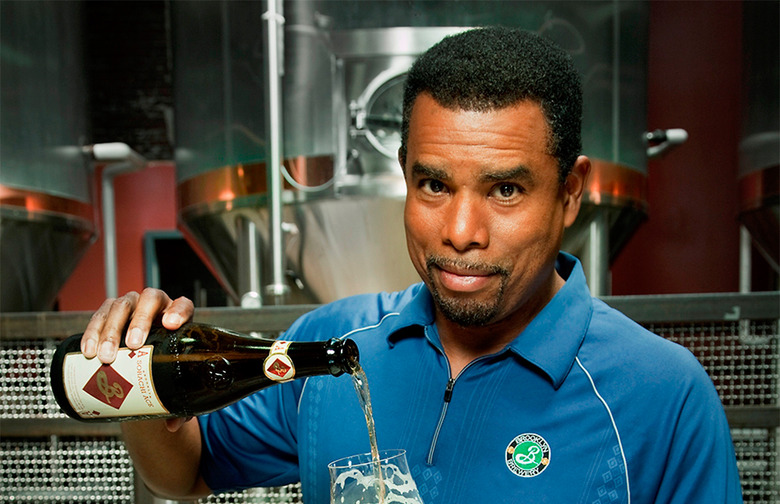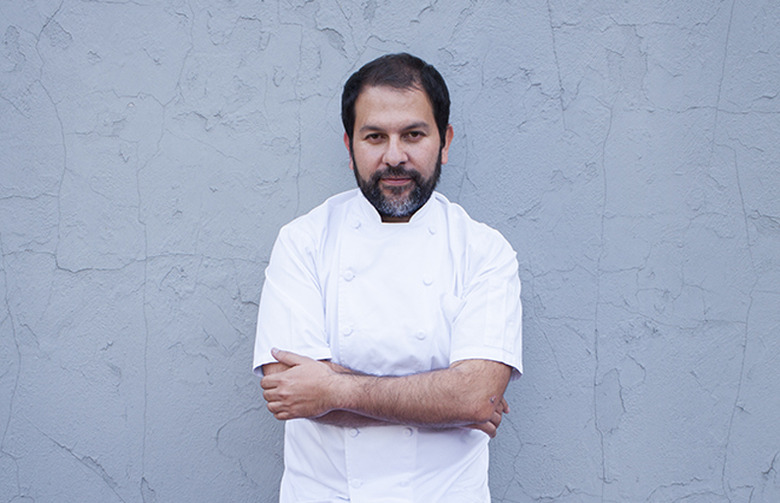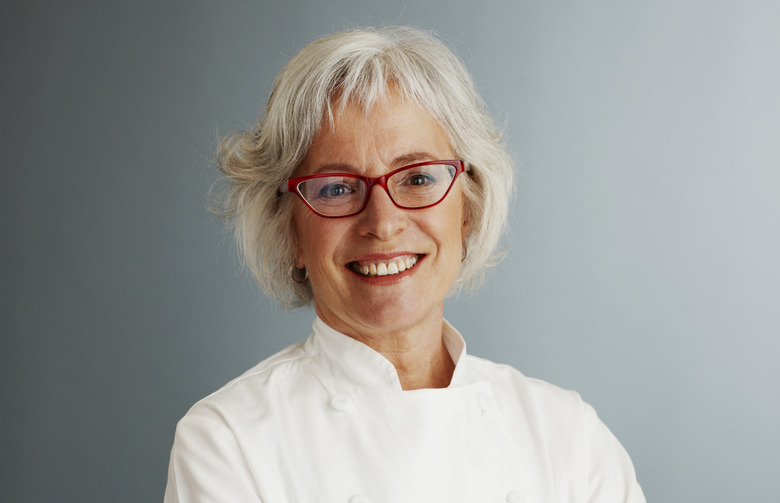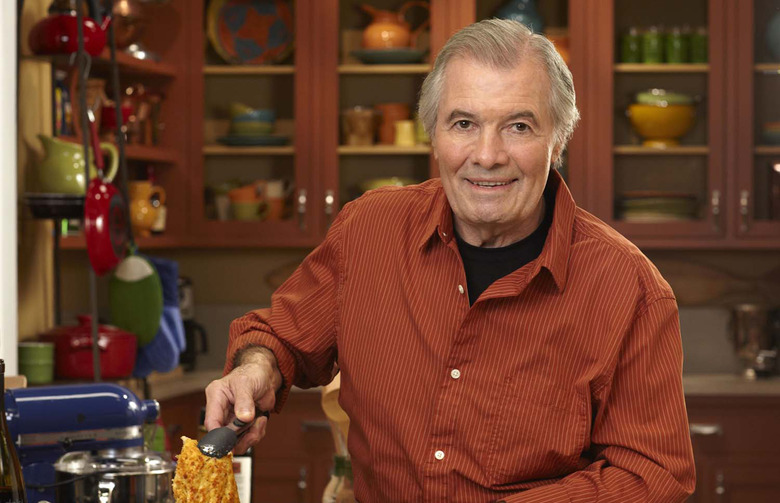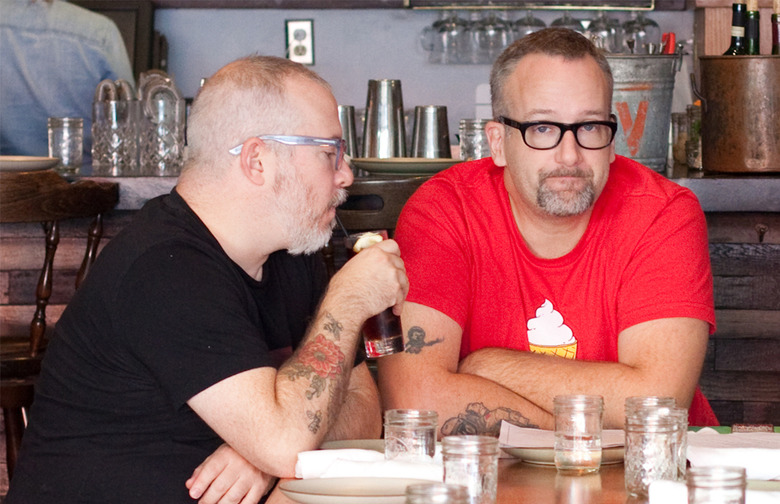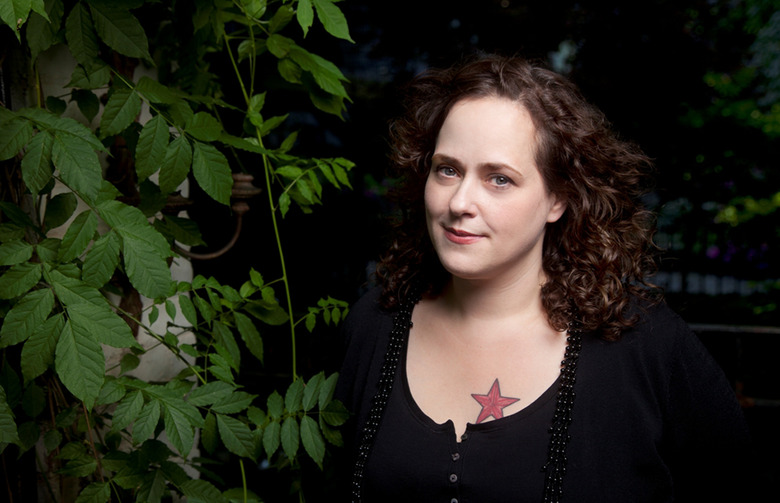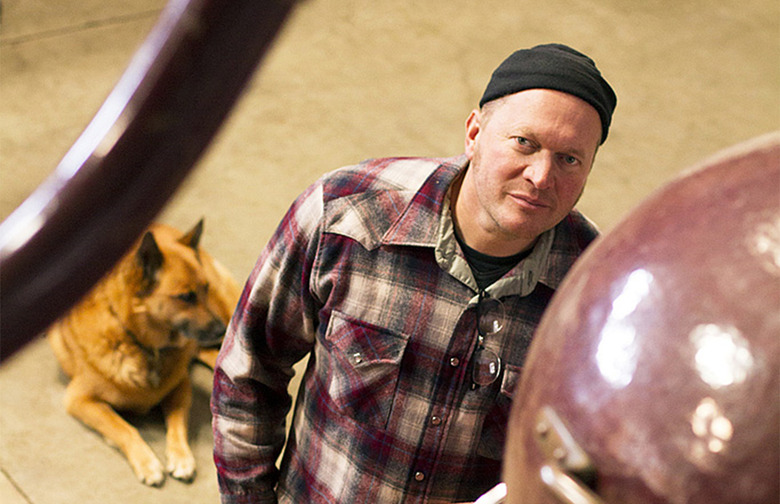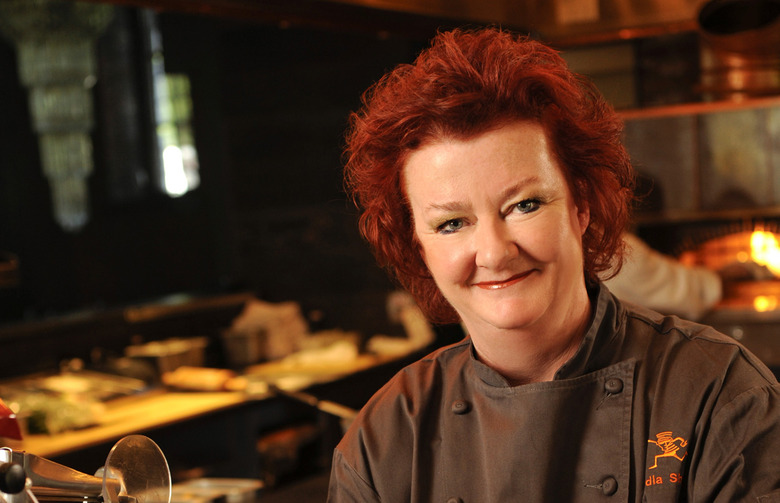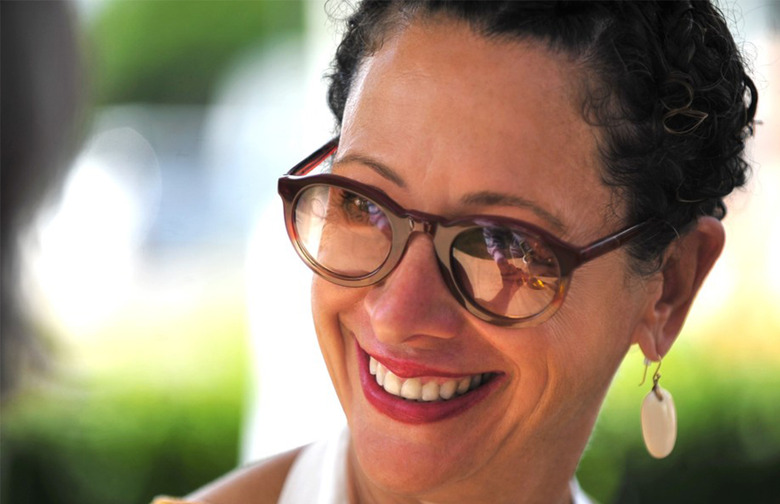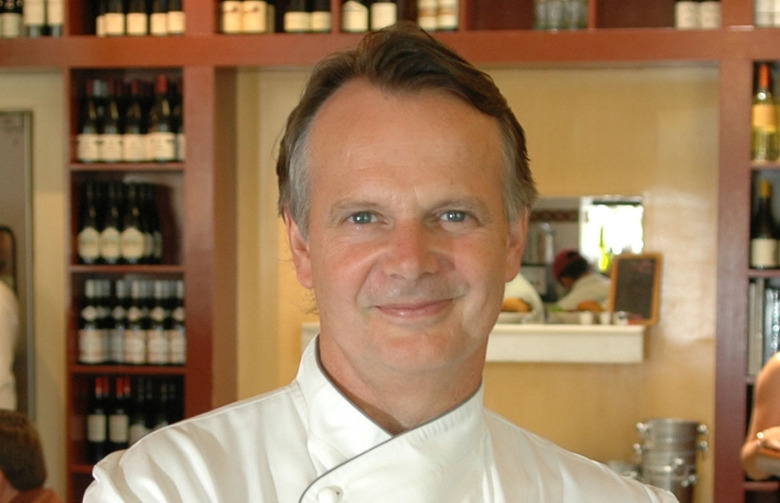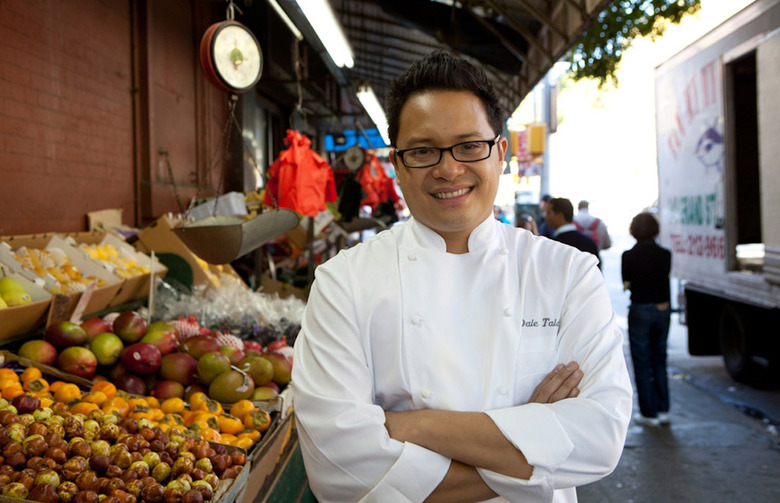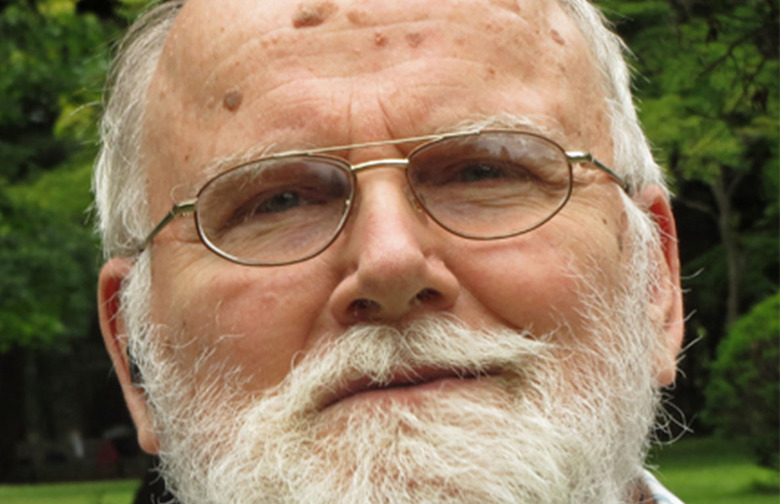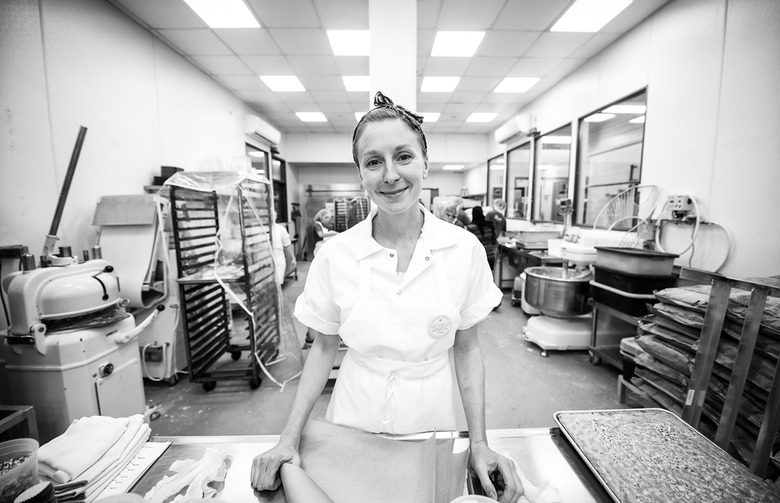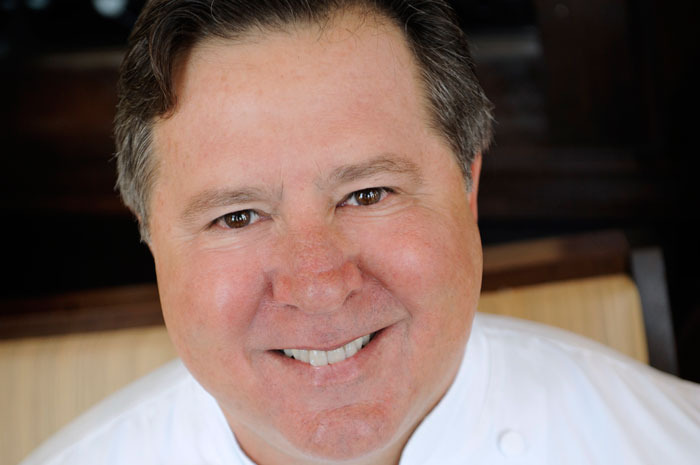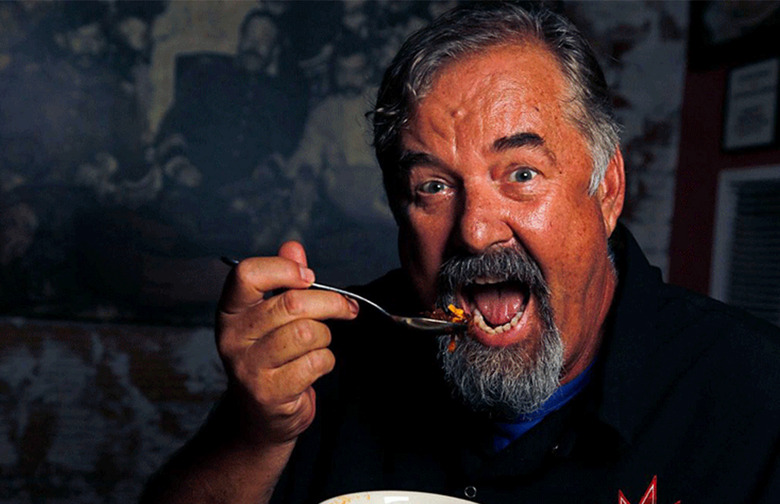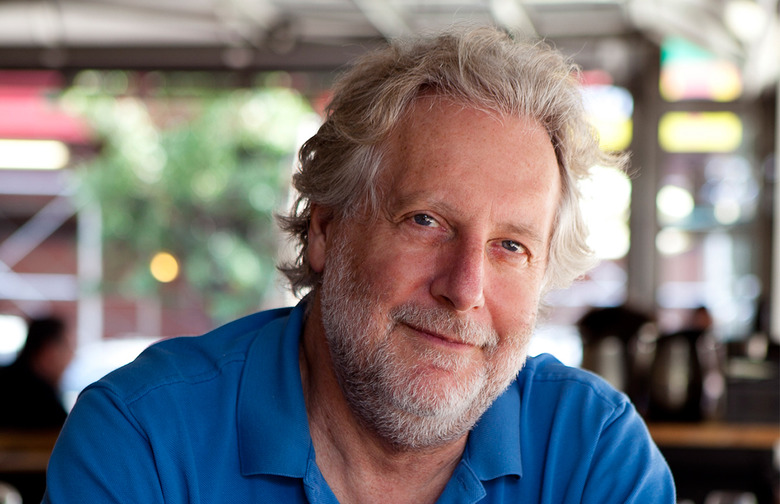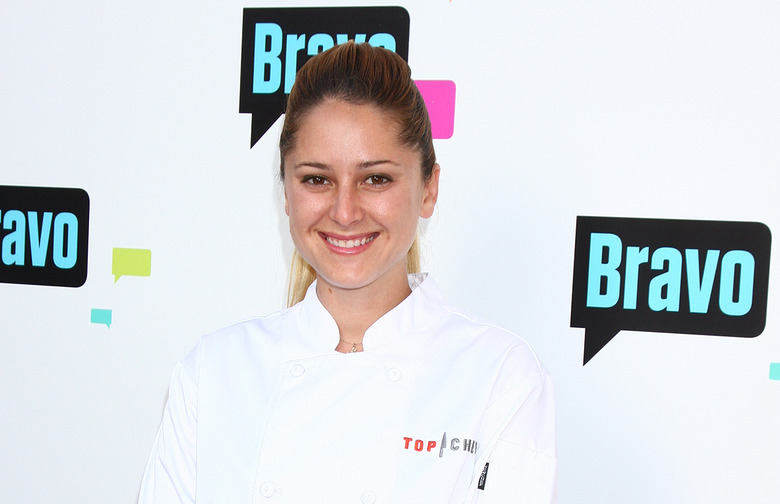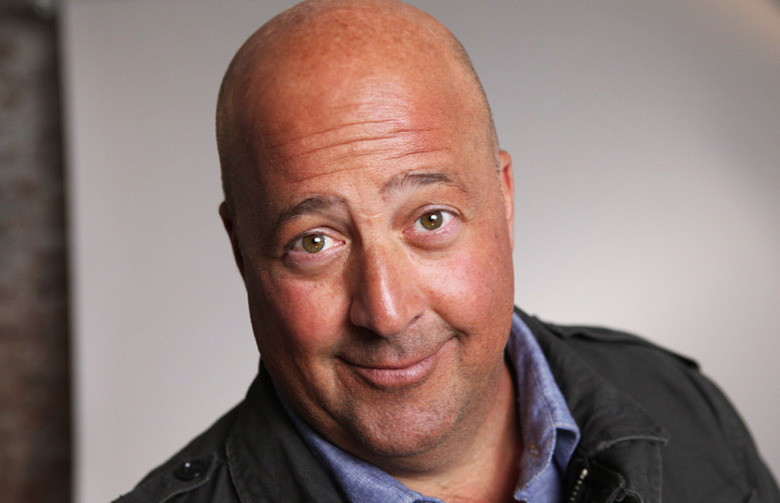The 60 (Plus) Coolest People In Food And Drink Slideshow
Grant Achatz's culinary pedigree includes training with Thomas Keller, Ferran Adrià, and the late Charlie Trotter. After basically being told by Trotter that he was persona non grata, he returned to Chicago and took over the city, first with Trio (making a suburb a must-visit destination for anybody serious about dining), and then with Alinea, where course after dazzling, perception-challenging course forged a distinctly American identity for what nobody really ought to call "molecular gastronomy." With his second restaurant, Next, Achatz and his business partner, Nick Kokonas, invented something new: a restaurant that changes not just menus but whole concepts every few months — and, incidentally, redefined the way restaurants think about reservations. Then there's Aviary, one of the most original cocktail bars in America, cooler than the crystal-globe-like ice forms that enclose some of the offerings (yes, the drinks are in the ice, not vice versa). This year, Achatz and company closed Alinea — named the 2016 James Beard Outstanding Restaurant ("a national standard bearer of consistent quality and excellence in food, atmosphere and service") — for refurbishing and bought his late friend Homaro Cantu's Moto, using the space for pop-ups until the flagship place reopens. (Future plans for the space haven't yet been announced.) The Alinea Group also opened a comparatively casual place called Roister, where the fare includes scallop crudo with mustard, passion fruit, charred daikon, and a whole chicken with chamomile, braised, poached, and fried with sunchokes. One cool move after another.
José Andrés
Where in the world is José Andrés? Washington D.C. (his home base), Miami, Los Angeles, Port-au-Prince, San Juan, Barcelona, and who knows where else, sometimes seemingly all in the same week. He must have more frequent-flyer miles than most of us have brain cells. Following this ceaselessly energetic and creative Spanish-born chef (and Daily Meal Council member) on Twitter can give you whiplash. Today he's down in the Haitian countryside, strategizing about his plan to help install clean-cooking parabolic solar ovens; tomorrow he's settling down to tortillitas de camarón at his favorite seafood restaurant in Cádiz; yesterday he was dining with chef friends at one of his Las Vegas restaurants. Last year, Andrés launched his promised fast food chain, Beefsteak — where the beefsteak in question is a tomato rather than a hunk of cow (these vegetarian spots are now in Philadelphia and the Washington, D.C. area) — and this year, as a cross-country counterpart to his Sin City animal-flesh emporium Bazaar Meat, he's opening Bazaar Mar, a seafood restaurant, in Miami. He's currently involved in a legal battle with Donald Trump, after having pulled out of a forthcoming Trump hotel in the nation's capital for what we assume will be obvious reasons. Wouldn't have been cool not to.
Lidia Bastianich
Can an Italian mamma be cool? This one is. Born Lidia Matticchio on the Istrian Peninsula, then part of Italy but now belonging to Croatia, Bastianich learned about food literally from the ground up on her grandparents' farm; they grew, raised, produced, vinified, and milled everything they could, and bartered their produce for the rest. Bastianich was right there with them, pitching in. She immigrated to the United States at the age of 12, and got her first food-related job at a bakery near her family's apartment in Astoria, Queens. Years later, in 1971, she opened a restaurant in Forest Hills with her husband, Felice Bastianich. A decade after that, the Bastianichs launched Felidia in Manhattan. With her children, Joe and Tanya, and longtime Bastianich associate Mario Batali (see below), Bastianich currently co-owns numerous restaurants, including Felidia, Becco, Esca, and Del Posto, all in New York City, and has a hand in the Eataly outposts in New York and elsewhere. Together with Tanya, she also runs a food product line and a television production company, has hosted and guest-starred in countless TV shows, and has written more than a dozen accessible, mouthwatering books. She is one of the most influential Italian culinary personalities in the country, but doesn't brag about it.
Mario Batali
He turned orange Crocs into a fashion statement. He hams it up with Jimmy Fallon. He traveled through Spain in a convertible with Gwyneth Paltrow, is opening the super high-end Italian megastores called Eataly right and left, and plays everything from Led Zeppelin to Neutral Milk Hotel — loudly — at his flagship Babbo (a fact that apparently made former New York Times restaurant critic Frank Bruni quiver). He and his partners (mostly Joe Bastianich) own at least a couple dozen (primarily Italian) restaurants in five states plus Singapore — the newest is La Sirena in New York City — and he makes daytime TV audiences swoon, or at least grin heartily, as co-host of ABC's "The Chew." Batali gets extra points for being responsive on Twitter, for owning the first Italian restaurant in 36 years to boast four stars from The New York Times (Del Posto) — and for remaining an unreconstructed party animal through it all.
Rick Bayless
The Oklahoma-born Rick Bayless is perhaps best known for hosting Mexico: One Plate at a Time, a cooking show on PBS that is now in its ninth season. Bayless, a member of The Daily Meal Council, has spent most of his career researching and sharing his knowledge on the culinary landscape of Mexico, and is the owner of Chicago's Frontera Grill and Topolobampo, the latter being one of America's first fine-dining Mexican restaurants. His most recent projects are Frontera Cocina in Disney Springs, Florida, and his Chicago-based outpost of Baja cuisine, Leña Brava. And how's this for cool: People often talk about restaurants being theatre, but a few years back, Bayless and two collaborators wrote and produced, and Bayless starred in, Cascabel: Dinner — Daring — Desire, the story of a meal in song, dance, and physical feats. The critic for The Chicago Tribune basically enjoyed the show, but allowed as how it could have gone further with "the Bayless persona, still a tad underwritten." That could have been underwriting, or it could have been just being cool.
John Besh
Even if John Besh didn't run a whole passel of terrific restaurants, mostly in New Orleans — including (but hardly limited to) two branches (one in Baltimore) of a collaboration with Aarón Sánchez called Johnny Sánchez; and four restaurant and bar concepts at the Crescent City's newly revivified Pontchartrain Hotel — he'd still be a key player in the Southern food scene through his John Besh Foundation. Founded in 2011, this organization is dedicated to helping to protect and preserve New Orleans foodways through programs like Chefs Move! (a culinary scholarship fund) and Milk Money (offering micro-loans to area farmers). Besh — who is also opening three venues in the Thompson Nashville Hotel and launching a Cajun/Creole brasserie next year in Houston — is known for putting his heart and soul into everything he does and for doing everything with that friendly Southern Louisiana smile.
April Bloomfield
She wanted to be a cop back in her native England but ended up going to cooking school instead, and cooked for a time at the Holiday Inn in her hometown of Birmingham. She eventually ended up at Terence Conran's showplace Bibendum, and later at the legendary River Café in London — where Mario Batali discovered her and brought her to New York to open what was almost certainly America's first gastropub, The Spotted Pig, with restaurateur Ken Friedman. The place was a smash success (and earned a Michelin star), and Bloomfield and Friedman have gone on to open two Manhattan musts — The Breslin and The John Dory Oyster Bar, both in the Ace Hotel — as well as Salvation Taco and Salvation Burger. Just for variety, they also revived an old San Francisco classic, Tosca. Bloomfield isn't flashy, but she has fun (she recently tweeted a photo of herself in a pig mask, noting "might do my whole meeting like this piggy style.I think I would freak my colleagues out though #innerchild"). She keeps her head down and does her things and gives us some of the best, most honest food around.
Daniel Boulud
Is it cool to be French? This seemingly indefatigable chef-restaurateur sure makes it seem that way. Three Michelin stars (two for his flagship Restaurant Daniel, one for Café Boulud, both in Manhattan), four stars from The New York Times, four James Beard Awards, the Chevalier de la Légion d'Honneur — if coolness were just based on awards and acclaim, he'd be the coolest guy in the room on that alone. Today, Boulud runs roughly 20 restaurants, bars, and épiceries (food shops) in New York City and five other American and Canadian metropolises, Singapore, and London, and they're all star quality. Add to that the fact that Boulud, a member of The Daily Meal Council, created the foie gras burger, that he has his own smoked salmon, and that his restaurant DBGB pays homage to the much-missed punk venue CBGB.
Jimmy Bradley
He walks cool, he talks cool, he cooks cool. His restaurant The Red Cat, in New York City's artsy Chelsea quarter, has been the definitive hip neighborhood restaurant since 1999, appreciated equally for its tempura green beans, its squid ink tagliatelle, and its grilled heritage pork with crispy white polenta and Calabrian tomato sauce (there are definite Italian accents to Bradley's American market menu). His other notable establishment, The Harrison, was the first restaurant to open in Tribeca after 9/11 and helped reinvigorate that mortally damaged corner of Manhattan (it closed late last year). He has a consulting firm and has been seen on food TV in various contexts, but he doesn't make a big deal about it. He's just a guy who likes to cook. And that's enough.
Sam Calagione
This Delaware-based brewmaster — he's the founder and president of Dogfish Head — grew up in an Italian family in Massachusetts that made wine in the basement, found out (coincidentally?) that he preferred beer, and got the brewing bug in 1992 working at Nacho Mama's Burritos in Manhattan bar, where the bar was stocked with microbrews. When he started making his own beer — he founded Dogfish Head as a brewpub in Rehoboth Beach in 1995 — he didn't want to turn out just the same old suds. He made beers flavored with maple syrup and peat-smoked barley, spirulina algae, and cocoa powder, honey, and annatto, and made a beer called Bitches Brew in honor of the seminal Miles Davis album of the same name. He concocted brews based on archeological beer residues found in China, Egypt, Turkey, and Honduras. He even made a hybrid beer-wine potion called Noble Rot, working with Washington State winemaker Jarrod Boyle of Alexandria Nicole Cellars. We think all this is as cool as an icy lager (like, say, Calagione's My Antonia, a tribute to the Willa Cather novel of the same name) — but just to up the ante, Calagione collaborated with Mario Batali and Joe Bastianich on La Birreria atop the New York City Eataly — and, in addition to numerous TV appearances as the brewmaster that he is, played a character called Fido in a 2014 bromance short called Trust Me, I'm a Lifeguard.
David Chang
Sure, there's the hype and the attitude, the highly unconventional food magazine Lucky Peach, the ever-growing New York restaurant empire (the latest additions to which are Momofuku Nishi, which does Italian Chang-style, and a delivery-only enterprise called Ando), the pork buns, the ramen, the fried chicken two ways (plus the fried chicken sandwich at his Fuku, which already has lines around the block); there's the aesthetic, the online reservation systems for special meals, the attention to detail (service and otherwise), and the fact that Chang showed a generation of chefs that you could open up a new class of quality-dining restaurants without the white tablecloths. There's the fact that Time Magazine named him one of the "100 Most Influential People" in the world in 2010, and that the James Beard Foundation inducted Chang into the Who's Who of Food and Beverage in America. There's the success with which he has expanded to, and galvanized the restaurant scenes in, Sydney and Toronto; the audacia with which he opened. But most of all, there's the core coolness that started it all, the fact that with his first restaurant, Momofuku Noodle Bar, he put it all on the line — all that pork, all that soul — and success or failure, he was going to do it the way he was going to do it, vegetarians and fussy restaurant nostalgics be damned, and he did.
Roy Choi
It's somehow fitting that while Virginia-born, New York-based Korean-American chef David Chang (see above) sparked a restaurant revolution when he opened his first Momofuku Noodle Bar in a hole-in-the-wall in Manhattan's East Village, Seoul-born, Los Angeles-based Korean-American chef Roy Choi sparked his California-style — on wheels. His Kogi BBQ Taco food truck, which he launched in 2008 in partnership with Mark Manguera and Caroline Shin-Manguera, broke ground while covering ground, serving bold Mexican-Asian hybrids like kimchi or sweet chili chicken quesadillas, tofu tacos, and spicy pork burritos in locations around LA, revealed to hungry Angelenos via social media — and the next thing anybody knew, kimchi was meeting jalapeños on every street corner in urban America. Choi's fleet now includes three trucks, which range all over LA and Orange counties, and Choi was named one of Food and Wine magazine's Best New Chefs of 2010 — a first for a food-trucker. Not that he stayed just a food-trucker for long. Today, Choi has two restaurants, POT and Commissary, in Koreatown's Line Hotel; taquerías in Culver City's old-school Alibi Room cocktail lounge and in the West LA community of Palms; a Caribbean-themed place called Sunny Spot in Venice; and a sit-down restaurant called Chego!, also in Palms. He is also collaborating with esteemed San Francisco chef Daniel Patterson (Coi) on the first units of a "revolutionary fast food" chain called LocoL, so far in Watts and Oakland. In his spare time, he consulted with Jon Favreau on Chef, kicked off a CNN series called Street Food, published a memoir with the self-explanatory title of L.A. Son: My Life, My City, My Food, and tantalized us by hinting that he might open something in New York City one of these days — all without going corporate or losing his stoner cred. LA Weekly called him "your favorite rapper's favorite chef." Our kind of trucker.
Jim Clendenen
He has been described as looking like the drummer in a Southern jam band, has made wines inspired by Mexican wrestlers and Italian porn stars (and more recently, his family dog), and owns more Hawaiian shirts than Don Ho. More to the point, through his Santa Maria-based Au Bon Climat winery and related enterprises, Clendenen is as responsible as anyone for earning Santa Barbara County its reputation as the source of some of the best wines in America — and his chardonnays and pinot noirs are good enough to make producers in his beloved Burgundy more than a little nervous. (His pinot blancs and pinot gris aren't bad either, and he's had increasing success with Italian varietals as a side project.) Just to seal the deal, Clendenen is also known as one of the best cooks in the winemaking community.
Amanda Cohen
The fact that Amanda Cohen owns an entirely vegetarian restaurant is cool in itself, but what's even better is that it's really good. Embracing "haute vegetable cuisine," Cohen is keen on the dining experience and created Dirt Candy — which recently moved into new, larger quarters — with the idea that guests at the restaurant should feel like they're in the comfort of her own kitchen. She's also penned a comic book-like cookbook, making hers stand out among the plethora of vegetable-based cookbooks out there and adding a bit of life to the cooking experience. Cohen doesn't hide her opinions under a cabbage leaf, either. A couple of years ago, she called out Time Magazine for not including any goddesses in its "Gods of Food" issue; more recently, she began a semi-regular column for Eater.com, in one of which she asked, "How soon is too soon to review [a restaurant]?" No one is more critical of Dirt Candy than she is, she wrote. A restaurant is never finished — "But at a certain point, you've got to let it go." Cool.
Ron Cooper
Cooper's light sculptures and other environmental installations are in the permanent collections at New York's Guggenheim Museum and the Los Angeles County Museum of Art — but after he discovered true artisanal mezcals in the Oaxaca countryside in 1990, he saw a different kind of light and made it his mission to bring these unique and powerful spirits to an American audience. (He's now working on a book called, appropriately enough, Finding Mezcal.) To say that he succeeded would be understatement. With Cooper leading the way, mezcal has become the hottest spirit of the times in trendy boîtes and funky cantinas alike all over the country. The label he founded, Del Maguey, doesn't traffic in mild, anonymous mezcals that are trying to be tequila; these bottlings, with unique and instantly recognizable labels by the late ceramic artist Ken Price, are produced in tiny villages, down dirt roads, absolutely by hand, from agave hearts roasted in stone pits and ground in horse-powered mills, and they're full-bodied, often smoky, and flavorful as hell. Some of his mezcals are made from rare wild agave varieties — and his Santa Catarina Minas Pechuga undergoes a third distillation with wild mountain plums and apples, red plantains, pineapples, almonds, and raw rice added to the mix, with the vapor condensed over a raw chicken breast (pechuga) said to mitigate the sweetness! To help ensure that such traditional treasures won't be lost, the affable Cooper has even founded a nonprofit organization with a name almost as mouth-filling as Del Maguey's products: the Foundation for the Sustainable Development of the Producing Communities of Maguey and Cultural Rescue of Mezcal. Even the James Beard Foundation eventually realized how cool Cooper was, naming him Outstanding Wine, Beer, or Spirits Professional earlier this year.
Darrell Corti
One sign of how cool this Italian-American Sacramento grocer — he's the proprietor of Corti Brothers market — is the fact that he'll think the whole idea of being considered cool is just plain silly. Running the family business in the California capital is a full-time job, and he doesn't have spare moments for a lot of folderol. Of course, Corti is a grocer like Sonny Rollins plays some tenor saxophone. Corti is simply one of the most deeply knowledgeable food and drink experts in America, able to expound with equal authority on Chinese tea, Spanish vinegar, Central Asian wine, Italian pasta, and about 30,000 other gastronomic topics. The Corti Brothers online store, where you can buy their Italian specialties even if you don't live in Sacramento, remains charmingly low-tech and straightforward, giving away very little about the vast treasures and culinary knowledge amassed by this family. At the store itself, you can shop for everything from toilet paper and skim milk to artisanal soy sauce and sherries so rare you can't even find them in Spain — or just stand in line for one of the California capital's best deli sandwiches. Corti, a member of The Daily Meal Council, knows everybody worth knowing in his chosen field, and everybody knows him. They call him "The Professor." If you've never heard of him, well, that sort of makes him even cooler, you know?
Camas Davis
It's all about the meat. Davis was the research editor at Saveur Magazine, and then went off to Portland, Oregon, as managing editor and food editor at Portland Monthly. Somewhere along the line, she decided that she wanted to learn the butcher's craft, so she did an apprenticeship at a butcher shop and charcuterie in France. Back in Portland, she hoped to pursue her studies of the skill, but couldn't find a place to do it — so she launched a butchery school of her own, the Portland Meat Collective, drawing some of the region's best chefs and butchers in to teach classes. Soon, she was skilled enough to start teaching classes herself. Today, the PMC tutors students in such subjects as basic beef butchery, sausage making, and basic rabbit butchery and charcuterie, and Davis, part of The Daily Meal Council, takes her message of cutting what you're going to chew even into local schools. If you've seen Davis in those Wusthof knife ads, you know that she can handle a blade with real savoir-faire. You can read more about her next year when her (as Publisher's Weekly puts it) "memoir of mid-live reinvention through a riveting education in meat, at the hands of four charismatic brothers in Gascony..." is published.
Robert Del Grande
A onetime California biochemist, the wry, soft-spoken Del Grande, a member of The Daily Meal Council, moved to Texas more than two decades ago and turned himself into one of the best and smartest "new Southwestern" chefs, galvanizing the Houston dining scene with his Café Annie and the lamented Taco Milagro. Today, Café Annie has morphed into the buzzy RDG + Bar Annie, and Del Grande also oversees two restaurants at Discovery Green, Houston's downtown "signature" park, The Lakehouse and The Grove. Along the way, he started playing guitar and singing with Dallas chef Dean Fearing and a changing cast of other colleagues, at first casually in hotel rooms and later with their band, The Barbwires, sharing the stage with people like Steve Winwood, Rodney Crowell, and Richie Furay. When legendary rock bassist Jack Bruce (Cream) died a couple of years ago, says Del Grande said, "I (somehow) felt obliged or inspired to play the bass," which led to an attempt to interpret the Bach cello suites on the instrument. Returning to his scientific roots, Del Grande also once concocted the first-ever Texas-made gin, called Roxor, flavored with Texan botanicals. The project ran aground — "Making gin is like guitar playing," says Del Grande said. "It's tough to get all the strings in tune at once" — but he plans to relaunch it this year.
Dom DeMarco Sr.
Dom DeMarco is beyond cool; when it comes to New York City pizza, he's a legend. Arriving in New York City from Caserta, near Naples (the birthplace of pizza), in 1959, he opened Di Fara Pizza on Avenue J in Brooklyn and has been doing it his way, pie by pie, ever since. The pizzas — stretched-out dough, ladled sauce, sprinkled cheese, a drizzle of oil, scissor clippings of fresh basil — are all lovingly prepared by DeMarco himself, how and when he wants. Then they're ravenously consumed by inevitably long lines of both locals and tourists in the know. As a distraction to the waiting hordes, the Di Fara family opened a café and cannoli emporium called Di Fara Dolce FATTS, just around the corner from the pizzeria — but as far as pizza-savvy New Yorkers are concerned, if you haven't braved the masses to enjoy a Di Fara pie, you don't know pizza at all.
John T. Edge
For starters, Edge looks cool: He was wearing thick-rimmed glasses long before every hipster in America started sporting a pair, and his signature soul patch actually somehow actually lends him soul. Not that he wouldn't have it anyway. As an author of books dedicated to (among other things) fried chicken, apple pie, burgers, and the food truck culture (and is working on The Potlikker Papers, a history of the modern South through food, from lunch-counter sit-ins to the present day); director of the Southern Foodways Alliance (which studies, promotes, and preserves the kind of food we all want to eat); contributor to The New York Times, Oxford American, and Garden & Gun; and frequent and entertaining tweeter extraordinaire, Edge is an American culinary treasure. This Daily Meal Council member continues to champion the best food that the American South has to offer, and just knows a whole lot about food in general. If you let him, Edge will utterly school you on why Southern food matters: "Our beloved provincial dishes serve as unifying totems of people and place." See? Cool.
Elizabeth Falkner
From her signature blonde rock star hair to her offhanded ease in any kitchen, Falkner just plain radiates cool — whether she's making James Beard award-winning pastries, excelling in the Worldwide Pizza Championships in Naples (she won first place in 2012 with her Finocchio Flower Power Pizza) , challenging Geoffrey Zakarian on The Next Iron Chef, or baking a cake for Muhammad Ali's 70th birthday. These days, the San Francisco native is no longer chained to a restaurant. She's writing a memoir (to add to her two cookbooks), working on food installations (she's an artist as well as a chef), doing motivational speaking and web projects on "Warrior Wellness" and being "Fit to Cook," and appearing at food festivals and charity events all over the place — doubtless doing it all with her usual calm efficiency.
Susan Feniger
She may be known to most of America as one of TV's Too Hot Tamales — with longtime colleague Mary Sue Milliken, her collaborator in the Border Grill restaurants in Santa Monica and four other locations (plus a truck), among other enterprises — but she's one cool character. Feniger has gained renown as an expert on the cuisines of Mexico and Latin America and on international street food (she even opened a restaurant devoted to it, Street, now closed). But she is also an exuberant personality (try to find a photo of her where she's not laughing or at least grinning broadly) with a magnificent mane of hair and lots of earrings, who once revealed that her childhood hero was legendary athlete Jim Thorpe. In 2013, Feniger, a member of The Daily Meal Council, was given the Elizabeth Burns Lifetime Achievement Award from the California Restaurant Association. Later the same year, she opened Mud Hen Tavern — where the menu includes chicken and waffle croquettes and hangover burgers — inspired by her memories of going to minor league Mud Hens baseball games in her native Toledo, Ohio. Her latest addition is a sort of bricks-and-mortar food truck, if you will: a takeout opening on the side of Mud Hen, called Blue Window, where the food concept changes completely every six months (chili cheese Frito tamale and falafel-battered onion rings are among the current offerings).
Aaron Franklin
You don't mess with Texas, and you really don't mess with Texas barbecue. Texas barbecue tradition is full of ancient pitmasters with pits even older than they are. Franklin meets them on their own turf, with a pit that has been in business only since 2011. His Franklin Barbecue in Austin started as a food truck two years earlier, and from the beginning has turned out 'cue so good that you've got to line up early in the morning to have even a chance at sampling it. And in Texas, that's saying something. In fact, Franklin could build bigger pits, quadruple his seating, and hire 20 more assistants and probably make a fortune. He's more interested in making barbecue, though, at his own pace, and he sure hopes you like it. Members of the James Beard Foundation obviously did, voting Franklin Best Chef: Southwest last year — the first time a barbecue chef has ever been so honored (and possibly the last). Also last year, Franklin published his first cookbook, Franklin Barbecue: A Meat-Smoking Manifesto — and this year he announced the creation of a new food festival in Austin (name and date not yet decided), in partnership with Mike Thelin of Feast Portland (the Oregon food capital's big annual culinary do) and James Moody, who owns the Austin music club Mohawk, as well as a local creative agency called Guerilla Suit. Cool company.
Jonathan Gold
What's cooler than a guy who won a 2007 Pulitzer Prize for his food criticism (to add to his many other honors) but continues to use his influence to shine a light on the small, mom-and-pop "ethnic" restaurants in Los Angeles? If Gold can write a vibrant, captivating column about an outstanding Thai restaurant in a strip mall located in the middle of nowhere — and as a result get throngs of Angelenos to venture there for a meal — that's definitely cool. (Dana Goodyear's piece about Gold in The New Yorker was subtitled "Pig's ear, octopus, and fish-kidney curry with L.A.'s most adventurous eater.") These days, Gold — a member of The Daily Meal Council — plies his trade for the Los Angeles Times. Besides his regular columns for the paper, he produces an annual list of his "101 Best Restaurants" in the LA area, and nobody should be surprised to learn that it ranges from the elegant Providence in first place to the plastic-chopstick pan-Asian "semi-permanent... pop-up" called the Starry Kitchen, with Mariscos Jalisco, Park's Barbeque, and Din Tai Fung along the way. To get a glimpse of how Gold does it, chill out with a look at Laura Gabbert's 91-minute-long documentary on the man, City of Gold.
Randall Grahm
Lanky and long-faced, with an abundant ponytail and owlish glasses, Grahm was one of the original "Rhône Rangers" — American vintners who specialize in working with southern French grapes — and may well have coined the term. It's his kind of pun. He bottles wines at his acclaimed Central Coast winery Bonny Doon Vineyards called things like The Heart Has Its Rieslings and Thanks, Semillon (as well as one called I'm Not Drinking Any £#ƒ€!¢ Merlot!) and his book, Been Doon So Long, includes chapters with titles like "Trotanoy's Complaint," "Howlbariño," and "The Love Song of J. Alfred Rootstock." It's not all talk, though: Grahm continues to produce lots of very cool and unusual — and really good — wine, much of it Rhône-inspired. (He also makes Querry Cider, using four kinds of pears, 10 varieties of apple, and two kinds of quince.) His latest project — crowdfunded through Indiegogo — is an experimental vineyard called Popelouchum (from the indigenous Mutsun word for "village" or possibly "paradise"), where Grahm aims to breed 10,000 (yes, that's right) new, genetically distinct grape varieties — $100 donors get to name their own varietal — and blend them into a unique "Grahm Cru." That's either completely crazy or really cool.
Hannah Hart
Hannah Hart is the cheery comedian and internet personality behind the insanely popular weekly YouTube series My Drunk Kitchen, and with more than 2.5 million followers she's a certified powerhouse. On the show, she attempts to cook everything from crab cakes to baked brie while slightly intoxicated, usually inviting her (equally entertaining) friends along for the ride. The 29 year-old also runs a second channel where she muses on life in general. Then there's her parody cookbook, My Drunk Kitchen: A Guide to Eating, Drinking, and Going with Your Gut — and she's beginning to make the transition to film and television, all on the back of her effervescent brand of effortless cool.
Brooks Headley
Lots of chefs play music on the side, and lots of musicians love to cook, and so of course lots of chefs and musicians pal around with each other. When Brooks Headley is part of that equation, he could be on either side of the room. Since the 1990s, Headley has been a straight-out, full-fledged hardcore punk and indie rock drummer, part of bands like Universal Order of Armageddon, (Young) Pioneers, and Wrangler Brutes. On the other hand, presumably using a lighter hand, Headley won the 2013 James Beard Award as Best Pastry Chef for his creations at Del Posto, the elegant Italian restaurant in New York City run by Mario Batali, Joe Bastianich, and Lidia Bastianich. (Despite his name, Headley comes from a family of Calabrian origins.) Headley took jobs in the industry originally just to make money, but turned out to have a natural talent for baking and confectionery. After working at a couple of top Italian places in the nation's capital, he toiled for Nancy Silverton at Campanile in LA, then snagged pastry chef gigs at a couple of New York City restaurants before moving to Del Posto. There, in addition to his favorite ingredients (salt and powdered sugar), he sometimes incorporated vegetables into his desserts and was a longtime vegetarian. Maybe it isn't too surprising, then, that last year he left upscale Italian behind and opened his own place in downtown Manhattan — Superiority Burger, where the burgers are made without benefit of animal flesh. Talk about marching to the beat of a different drummer.
Christopher Hirsheimer & Melissa Hamliton
The California-born Hirsheimer (Ms. Hirsheimer, lest the name confuse you) has lived in Northern California, Australia, Hawaii, Illinois, and Pennsylvania, and has been a restaurateur, a corporate chef, a caterer, a food stylist, a magazine editor and co-founder (Saveur), and most of all, a game-changing food photographer, now widely imitated for her accessible, sensuous, natural-looking images. (Look for her work in books by Julia Child and Jacques Pépin, Rick Bayless, Frank Stitt, and The Daily Meal's own Colman Andrews, among many others.) Her colleague, Melissa Hamilton, a native of New Jersey, once ran the test kitchen at Saveur and before that was the co-founder and executive chef of her father's popular Hamilton's Grill Room in Lambertville, New Jersey. Today, the two (both members of The Daily Meal Council), under the byline Hamilton & Hirsheimer, are redefining cookbook publishing with their unique — and frankly gorgeous — Canal House series of periodical cookbooks, while they create and document wonderful lunches daily (for themselves only, alas) at their New Jersey studio. (A few years back, Andrews McMeel published a collection of their recipes and aperçus, Canal House Cooks Everyday, and they're working on a new volume, Canal House Kitchen Basics.) Trust us: they are the coolest lunch ladies you'll ever meet.
Eddie Huang
We used to think Eddie Huang was too hip — or too hip-hop — to be cool, but this one-time corporate attorney and streetwear clothing designer and current chef–restaurateur (BaoHaus, a Taiwanese-style steamed-bun house in Manhattan's East Village), author (of, most recently, Double Cup Love: On the Trail of Family, Food, and Broken Hearts in China), TV personality, and situation-comedy fodder (ABC's Fresh Off the Boat is based — pretty loosely — on his memoir of the same name), has been so persistently, unapologetically contentious, entertaining, and smart that we've come around. There's nothing low-key about Rich Homie Huang (as he styles himself on Twitter), but talk about somebody who goes his own way without glancing at the peanut gallery. Angry? Sure sounds like it. Abrasive? Yeah, to those who need abrading. But if the intersection of food and culture (in the broadest sense) is your thing — and maybe it should be if it isn't — Huang is too cool to eschew.
Stephanie Izard
Sure, she has a degree in sociology from the University of Michigan; sure, she was the first female chef to win Top Chef; sure she won a James Beard Award as best chef in the Great Lakes region. She even had the moxie to go up against Ohio superchef Michael Symon on Iron Chef America (she showed well, but he showed better). And she has a dog named Burt. All good things — but the reason we think Izard is so cool is that she celebrates one of the most delicious and protean but (in mainstream U.S. dining, anyway) least appreciated food animals on earth: the rascally goat. At her Chicago restaurant Girl & the Goat, she serves goat in myriad forms (goat empanadas with smoked blueberry tapenade, anyone?) along with such other examples of real if uncommon food as escargot ravioli, duck tongues with tuna and black bean poke, and wood-oven-roasted "pig face." Across the way, at Little Goat, she elevates the diner genre to gastronomy without losing its basic proletarian appeal (here the goat is found primarily in chili for the chili cheese fries)— and in March she opened — why not? — a Chinese-inflected restaurant called Duck Duck Goat. The cool part about all this is that she's basically just doing what she wants, and it turns out that we want it, too.
Lee Jones
A bow tie with overalls? An unconventional look, to be sure (don't try this at home), but Lee Jones rocks it. Never mind the wardrobe, though. Consider what Farmer Lee Jones (as he likes to be called) represents: The Chef's Garden and the associated Culinary Vegetable Institute, a "chefs' haven" that culinary professionals can use for "educational, team-building, and retreat purposes." In the 1980s, after losing a large part of their harvest one year to hailstorms, the Jones family decided to focus on the needs of chefs, developing exceptional specialty and heirloom vegetables, herbs, microgreens, and edible flowers. Many of the big names in the industry today, like Thomas Keller and Daniel Boulud, get their produce from Jones, and he also worked with the late greats Julia Child and Charlie Trotter. Farmer Lee was growing the kinds of produce everybody uses today when most of the folks who use them were mere sprouts themselves.
Kat Kinsman
You wouldn't miss Kat Kinsman in a crowd. With her black hair, usually worn either flowing down her shoulders or with shaggy bangs surmounted by a bun the size of a small loaf of artisanal bread, her fire-red lipstick, her striking facial architecture, and above all her supreme if somehow reticent self-confidence, she looks like a film noir villainess — and pretty much commands the room. The former editor-in-chief of Tasting Table, and before that managing editor of Eatocracy, Kiinsman is now Senior Food and Drinks Editor at Time Inc.'s website Extra Crispy — which is all about breakfast and brunch. She has been an artist (she has an MFA in metalsmithing from SUNY New Paltz and once said, "When the apocalypse comes, I can forge weapons and tools for people"), a graphic designer and art director, an ad seller, and the receptionist in a psychiatrist's office. Her writing about food (and other subjects) is witty and savvy. She has a serious side, too, though: She's the founder of Chefs with Issues, aimed at raising awareness of mental disorders among chefs and reducing the stigma associated with seeking help for them. Her book Hi, Anxiety: Life With a Bad Case of Nerves is due out in November — and her Twitter handle is @kittenwithawhip. Nuff said?
Barbara Lynch
A high school dropout from South Boston and one of seven kids raised by a single mother, Lynch discovered cooking in home ec class before leaving school, got her first restaurant job as a teenager, and through talent and hard work — and a stint working for Todd English — ended up as the owner of the Barbara Lynch Gruppo. Under the Gruppo umbrella are two of the highest-rated restaurants in Boston, No. 9 Park and Menton, as well as such popular establishments as B&G Oysters and Sportello. Through it all, Lynch has remembered her roots, and in 2012 established the Barbara Lynch Foundation with the goal of imbuing "urban youth in at-risk Boston communities with the essential life skills to get Up and Out!" Cool-kid chefs on the order of Daniel Boulud and Michael Tusk have signed on to help.
Sirio Maccioni
For more than 40 years, Tuscan-born Sirio Maccioni has run one of Manhattan's ultimate glamour-and-power restaurants, Le Cirque, moving and reinventing it twice along the way. He long had a reputation in some circles as a snobbish, autocratic gatekeeper who pandered to VIPs (like Frank Sinatra, Jackie Kennedy, and, oh, Pope John Paul II) and disdained hoi polloi. (Ruth Reichl wrote a famous review of Le Cirque in The New York Times in which she dined first in disguise and then as herself, noting the vast difference in the way she was served as a "nobody" and as an important critic.) But he revealed himself in his 2004 memoir, Sirio: The Story of My Life and Le Cirque, as a passionate, consummately professional restaurateur who simply asks customers to respect the fine dining experience and welcomes anyone who understands the rules. He once said (we paraphrase), "You say we give preferential treatment to people we know? Then why don't you let us know you?" — and after he turned Frank Zappa away at the door one day for being underdressed, Zappa cleaned up his act and came back, and the two became great friends. That's one of the coolest things about the 83-year-old Maccioni — whose Le Cirque empire, run with his wife and two sons, now includes restaurants in Las Vegas, the Dominican Republic, Abu Dhabi, and New Delhi. Another is that he has been a judge for both Top Chef and the Miss Universe Pageant. Coolest of all, though, is that he has gone his own way throughout his professional career, and stood up, impeccably attired, for the standards he believes in.
Jack McGarry
Downtown Manhattan's acclaimed Dead Rabbit Grocery and Grog promises "Slings & Toddies, Horse's Necks, Juleps, Crustas, Flips and Follies, Scaffas, and Punches" — among other libations — and if anybody in the city would know how to make all those archaic tipples, it's Jack McGarry. "Bartender" doesn't begin to tell the story about McGarry. The Dead Rabbit, which he runs with his colleague Sean Muldoon, helped transform Manhattan's Financial District into "the place to be" years before the Midtown set moved in. McGarry, who has the cocktail-shaking ease of a master, was named Tales of the Cocktail International Bartender of the Year in 2013, the honor's youngest-ever recipient, but he hasn't parlayed that into a line of packaged drink mixes, a reality show, or a place on the minor-celebrity-bad-boy's list. He has just kept on doing what he loves: making intoxicating potions full of history and romance and great flavor. Which doesn't mean he's standing in one place behind that bar: he and Muldoon have just opened BlackTail, a timely Cuban-themed bar and restaurant on Battery Place, at Manhattan's far south end. We'll have a cool Cuba Libre, please.
Jeff Mauro
If you didn't realize that Jeff Mauro was going to win the seventh season of Food Network Star from the very first episode, you weren't paying attention. Since taking the crown in 2011, the exuberant Chicago native has been nominated for a Daytime Emmy for his own successful cooking show, Sandwich King, has provided comic relief over nine seasons of the wildly popular daytime talk show The Kitchen, and launched his own popular Chicago restaurant, Pork & Mindy's. The gregarious family man has the kind of personality that pulls you into its orbit, and his unique brand of silliness belies a low-key, comfortable cool.
Danny Meyer
A one-time tour guide in Rome and later field director for Illinois congressman John B. Anderson's 1980 presidential campaign, Meyer went on to work in a New York Italian restaurant, then studied cooking in Italy and France before opening a modest neighborhood place called Union Square Cafe just south of Manhattan's Flatiron District in 1985 (now closed, but reopening in a new location nearby this year). In an era when snobby maîtres d'hôtel still ruled in the city, he built the restaurant's reputation on its food, yes, but also on its impeccable service, aimed at giving customers not just dinner but a memorable experience all around. (For a look at the memorable experiences the staff was apparently enjoying, see ex-Union Square server Stephanie Danler's hit restaurant-business roman à clef Sweetbitter, in which a faintly sketched Meyer character appears occasionally, behaving impeccably.) Service became an obsession with Meyer — he eventually wrote a book called Setting the Table, outlining his philosophy of hospitality as it applies not just to restaurants but to business and the world in general — and every establishment opened since by his Union Square Hospitality Group upholds the same standards of customer care. Today, Meyer helms more restaurants than we can count, among them such New York City pace-setters as Gramercy Tavern, Maialino, The Modern, and, most notably, Shake Shack — the ever-expanding international burger chain that started life as a pop-up hot-dog cart in Madison Square Park, went public early last year with a valuation of over $1.6 billion, and now seems practically as ubiquitous as Starbucks. Through it all, the impeccably attired Meyer has stayed cool and kept his sense of humor and of scale.
Stephen Norberg
Root beer — a (usually) non-alcoholic beverage flavored primarily with sassafras root (some companies favor sarsaparilla root) — descends from a medicinal drink made by Native Americans for centuries before the first Europeans arrived on these shores. Modern root beer was first sold commercially by Charles Elmer Hires, a teetotaler who introduced it at the Philadelphia Centennial Exhibition in 1876. When he was a kid, says Stephen Norberg said, he loved root beer so much that he dreamed of becoming a professional root beer taster. As far as we can tell, there is no such thing — but Norberg has figured out a way to make root beer his profession, and we'll bet he can taste it any time he wants. In 2006, the year he graduated from Harvard with a B.A. in psychology (he estimates that his college diet was 60 percent root beer), Norberg founded Rootbeerkegs.com, "an online network connecting microbreweries, distributors, local businesses, organizations, and individuals to facilitate the use of root beer kegs to reduce underage drinking and alcohol abuse." In 2013, in Washington, D.C., he started Thunder Beast, a craft root beer brewing operation that sells a maple-and-honey-flavored basic beverage as well as seasonal variations, as spicy ginger beer, and even cold-brewed coffee. His mission, says Norberg said, "is to create the greatest drink ever tasted by a mortal." A frosty mug of Thunder Beast sounds pretty cool to us right now.
Garrett Oliver
"Brewmaster" is an inherently cool job title, but few of those who hold it are quite so cool as Garrett Oliver, the driving force behind the renowned Brooklyn Brewery in the New York City borough of the same name since he took the helm in 1994. The dapper and debonair native of Hollis, Queens — who produced concerts for the likes of The Ramones and R.E.M. while he was a student at Boston University — caught the home-brewing bug back in 1983, long before it became the craze it is today. A veritable beer encyclopedia, he's the perfect spokesperson for his forward-thinking brewery (which played a part in Williamsburg's uber-revitalization), and is also one of the country's leading authorities in cooking with beer and pairing it with food. When it comes to beer, Oliver doesn't just play the part. He lives it.
Enrique Olvera
This list of the coolest folks in food and drink is pretty much limited to Americans (America citizens, at any rate), not because there aren't enough cool people out there in the world at large but precisely because there are so many of them — we had to draw the line somewhere. We'll keep Enrique Olvera on this side of the line, however. Olvera, whose remarkable Pujol in Mexico City and other restaurants around his native country have made him the most famous chef in Mexico, deserves a place on this list for diving fearlessly into the notoriously competitive and not always hospitable world of New York City fine dining with Cosme. This cliché-shattering place, which opened last year and has been one of Manhattan's hottest restaurants ever since, redefines Mexican food with such dishes as uni tostada with avocado and bone marrow salsa, smoked raw cuttlefish with corn husk oil and salsa Mexicana, and black-garlic-rubbed New York strip steak tacos with shishito peppers and pea-avocado purée. Next for Olvera is a more casual (but we suspect no less unconventional) Mexican restaurant in New York's NoHo neighborhood. We think Olvera, who fell in love with America after studying at the Culinary Institute of America in Hyde Park, New York, and working at Chicago's elegant Everest, is cool because he's low-key, quirky, passionate about the flavors of Mexico, and at heart just a really good cook — something that frankly can't always be said for our restaurant celebrities.
Cindy Pawlcyn
Pawlcyn was doing local and sustainable before a lot of today's local and sustainable apostles could put their Pop-Tarts in the toaster by themselves. She once opened a restaurant in a building shaped like an Airstream trailer (Fog City Diner in San Francisco) and now she owns (among other places) the best restaurant in the Napa Valley that isn't The French Laundry: Mustards Grill, which has been going strong for more than three decades. And speaking of local and sustainable, Pawlcyn also now runs the food service at that beacon of piscatorial sustainability, the Monterey Bay Aquarium, on the cool California coast.
Jacques Pépin
When Jacques Pépin debuted what has been described as his last full TV series, Jacques Pépin: Heart and Soul, last year, it took him out of the kitchen — at least some of the time — and showed him at home, with his family, on the road, and in the past. (A book called Heart & Soul in the Kitchen followed up.) What's so cool about this French master chef, cookbook author, and teacher is that he probably doesn't even realize how cool his life looks to us, with all its hard work and unlikely detours (his first big cooking job, back in 1961, was developing recipes for Howard Johnson). He just knows that his native cuisine, unfashionable though it may be in some quarters these days, is important to the way we cook and eat today, whether we realize it or not. For decades, Pépin has generously shared his knowledge with the world through books, TV shows, and educational programs at places like the International Culinary Center and Boston University, and all we can say is, "Merci, maître."
Douglas Quint and Bryan Petroff
It was one thing, back in 2009, to meld an ancient American street-food tradition with up-to-date dessert ideas and launch an ice cream truck offering soft-serve ice cream cones with double-entendre names and super-indulgent flavor combinations (for instance, vanilla ice cream, Key lime curd, whipped cream, and crushed graham crackers); it was quite another thing, years before the Supreme Court finally did the right thing, to boldly dub it the Big Gay Ice Cream Truck. But that's just what Quint, a classical bassoonist, and his partner (in both senses), Bryan Petroff, did; it was a joke at first, they say, but the name stuck — and the public loved it. Two years later, the two opened their first brick-and-mortar establishment, the Big Gay Ice Cream Shop, in Manhattan's East Village. They upped the ante by developing a new kind of soft-serve in collaboration with Ronnybrook Farm Dairy, and ended up being named the fifth-best ice cream parlor in the world by USA Today. There's now a second Manhattan location and one in Philadelphia, plus a mini-outlet at the Ace Hotel in Los Angeles, with further expansion plans on the menu. When asked by NPR what made the enterprise gay, Quint responded, "I make it gay." He added that he wouldn't have used the name if he weren't also gay in the sense of being happy; "It would just be the big crabby ice cream truck," he said. Ice cream is cool by definition; Quint and Petroff make it cooler.
Jennifer Rubell
A graduate of both Harvard University and the Culinary Institute of America, self-described "mindful glutton" Jennifer Rubell once interned for Mario Batali and has exhibited her provocative art — including a piñata of Andy Warhol's head — in galleries and museums all over the world. What we think is so cool, though, is the way she stages larger-than-life food events, where you can eat the art. In Dallas, she's dripped honey from the ceiling onto a ton (literally) of baby back ribs, and in New York, she padded a room with 1,800 cones of cotton candy. And Rubell's cheese plate doesn't come served cubed or on a cheese board: It consists of elevated, life-sized cheese blocks in the shape of her head, blasted with heat guns, dripping onto stacks of crackers. She has also produced a series of "Drinking Paintings," in which everything from lemonade and Swiss herbal iced tea to dirty martinis and Irish whiskey become her media — with the twist that you can actually drink them all, straight from taps on the canvases. Last year she built a performance piece around bread and butter. This year she turned the new Kate Spade store in London into a "Sweet Suite," intermixing Spade accessories and handbags with desserts. Her art cooks.
Amanda Saab
President Trump will probably sic the FBI on us for this, but we hereby hail the unruffled self-confidence of Masterchef contestant and ebullient blogger Amanda Saab — the first person to appear on any U.S. cooking show, as far as we can tell, wearing a hijab, the traditional Muslim headscarf. Because, well, why not? Born in Dearborn, Michigan, of Lebanese descent, and now living in Seattle, Saab is a social worker who has loved cooking (and eating) since she was a little girl — she says that she used to watch Emeril Live instead of MTV — and who asked (and got) a KitchenAid stand mixer for her 16th birthday. On Masterchef's sixth season, last year, Saab wowed judges with dishes both Middle Eastern in inspiration (lamb kefta with sumac aîoli and jalapeño-dusted potatoes) and otherwise (crab cakes with mango apple salad and avocado cream sauce) — but was poleaxed by an underdone birthday cake in episode eight and eliminated. No matter. She's planning to write a cookbook and filling her blog with everything from Ramadan cooking tips to a recipe for red, white, and blue "popsicles" — very chill.
Rosie Schaap
At the age of 15, she writes wrote on her website, she was telling fortunes for beer "in the bar car of a regional railroad." Her father was the legendary sports writer Dick Schaap, and her cousin is the erudite jazz historian and radio personality Phil Schaap. This particular Schaap's sport, and her jazz, too, if you will, is cocktails — making them (she is a sometime bartender), writing about them, and most certainly enjoying them. Schaap, who writes a regular Drink column for The New York Times Magazine and two years ago published a memoir (and panegyric on drinking places she has known) called Drinking with Men, is also an ordained minister and former chaplain and the onetime librarian for a paranormal society, and has taught English and managed homeless shelters. With her cascading mane and almost cherubic smile, you'd spot her on a barstool in an instant — and if you're lucky, sidle up beside her for something cool.
Tad Seestedt
Back in the mid-twentieth century, the only "artisanal" distillers in America were likely to be moonshiners — the real ones — and maybe the occasional college professor, like the guy I knew at CalArts who made excellent citrus eau-de-vie with lab equipment in his art studio. Today, there are — well, let's call them craft distillers or micro-distillers — in every state in the Union, more than 600 of them in all. (It sometimes seems as if there are 600 in Brooklyn alone.) And if the new small-scale American spirits scene is cool (which it is), it's mavericks like Tad Seestedt who make it that way. Raised on a small farm in New York State's Finger Lakes — wine country — he ended up in another wine country, in Oregon, and started making wine in 1992. Four years later, he started what is now called Ransom Wine and Spirits (because he "ransomed" his savings and maxed out his credit cards to set up shop) and added grappa, brandy, and eau-de-vie to his catalogue. Today, he makes wine from all the expected Oregon varieties but also from malbec, Spain's albariño, and other such novelties in the region. What sets him apart, though, are his unique old-style spirits — straight American whiskey in the nineteenth-century style (with a recipe from cocktail guru and booze historian David Wondrich), a dry gin with a slight Dutch accent, an amber-hued Old Tom gin (again in collaboration with Wondrich), even a vodka — "The Vodka" — that actually has flavor of its own. Mix us a cool one.
Lydia Shire
Shire is cool and bad-ass. We named her one of our bad-ass woman chefs, in fact, for professional moves like taking over Boston's venerable Locke-Ober, which had banned women from the dining room for its first century of existence (it's now closed), and for having cooked "big" food, full of fat and flavor and impervious to trends, for decades. Shire, who favors black, pink, or pistachio-green chef's jackets and henna-red hair, got where she is her own way — hocking her wedding ring to go to cooking school after her first marriage broke up and working her way through every good kitchen in Boston, before opening Biba there, and electrifying Beantown palates with such fare as fried calf's brains with capers and black gnocchi with squid. Today, she serves great take-no-prisoners Italian and, well, Shire-ian, food at Boston's Scampo (in the Liberty Hotel, housed in the city's old Charles Street jail) and tells us that she's looking for a spot to open "a little jewel box bar." We're there.
Nancy Silverton
She opened one of the definitive LA restaurants of the late twentieth century, Campanile, with her then-husband, Mark Peel, and on the side, oh, just changed the world of bread in America with her next-door La Brea Bakery — which Silverton began as a small artisanal operation in 1989 and sold in 2001 for somewhere around $60 million. She invested her share of the proceeds with a guy named Madoff, and when that went south, what did she do? She joined up with Mario Batali and Joe Bastianich to help re-energize the city's dining scene with the wonderfully original and instantly popular Osteria Mozza (where she makes fresh mozzarella through the evening) and Pizzeria Mozza (there are now an Osteria and a Pizzeria Mozza in Singapore, too, as well as Pizzeria Mozzas in San Diego and Newport Beach). Then came Chi Spacca (Italian for "what splits" — i.e., "cleaver"), the kind of place that gives your vegan friends the willies, with its menu of things like house-made salumi, lamb neck stracotto, beef and bone marrow pie, pancetta-wrapped sweetbreads, and 50-ounce Florentine-style beef shop. Last year — speaking of coolness — Silverton launched Nancy's Fancy, a line of ice creams and gelatos that are, shall we say, not like the others (fancy, as it were, a scoop of Butterscotch Budino with Caramel Rosemary Swirl or maybe Spiced Stumptown Coffee with Cracked Cocoa Nibs?). Bread, cheese, meat, and ice cream. What's not to like?
Frank Stitt
As executive chef and proprietor of Highlands Bar & Grill in Birmingham, Alabama, which he opened in 1982, Stitt helped invent modern Southern cooking. Then, inspired by Arrigo Cipriani's approach to Italian cooking, he opened Bottega in the same city, following that with his native state's most authentic French bistro, Chez Fonfon. Stitt is a champion of local ingredients, especially the Gulf seafood caught off the Alabama coast, an influence on many other Southern chefs, and a really nice guy. He's a guy who drew on tradition to create traditions of his own, learned how to express them consistently and well, and figured out that the best way to succeed in the challenging restaurant game was to keep his head down (and cool) and make diners happy.
Dale Talde
It all started in Park Slope, Brooklyn: after performing impressively on not one but two seasons of Top Chef and cooking at both Morimoto and Buddakan in New York City, Chicago-born chef Dale Talde teamed up with restaurateur David Massoni and bartender John Bush to open his first restaurant, a pan-Asian place (he's of Filipino descent) named Talde — a neighborhood gem that's not only packed every night of the week but is bringing crowds in from Manhattan by the F train-full and boosting other local businesses along the way. For his next move Talde felt the urge to go low-brow, and that that he did, heading over to the other end of the neighborhood to open a roadhouse-style whiskey bar, Pork Slope. The cheap drinks, insanely delicious, no-frills bar food, and party-like atmosphere draw a slightly different type of crowd, but keep it packed at all hours of the night. Now Talde and his partners are also running the old-style Thistle Hill Tavern, a block from Talde, where the specialties include lobster (not crab) Rangoon, mac and cheese (with four cheeses), Thai mussels, chicken tikka masala, and regular, vegan, and falafel burgers. As if that's not enough, there are now Talde outposts in glamorous South Beach Miami and, well, interesting Jersey City. Earlier this year, it was reported that Talde and his partners would install not one but four different dining and/or drinking venues in a new hotel in New York's Chinatown (watch this space). This guy is clearly no follower; he invents his own style as he goes along.
Bryant Terry
The New York Times called Memphis-born Bryant Terry a "food fighter." He has shown up on Ebony's "Power 100 List" and Fast Company's "9 People Who Are Changing the Future of Food." An Oakland resident, he was named artist-in-residence at San Francisco's Grace Cathedral and chef-in-residence at the city's Museum of the African Diaspora, and was a Food and Society Policy Fellow for the WK Kellogg Foundation. Terry won a James Beard Foundation Leadership Award last year. Self-described eco-chef, author (of four books, most recently Afro-Vegan: Farm Fresh African, Caribbean, and Southern Rood Remixed), teacher, TV personality, and above all food activist, Terry believes that we should grow as much of our own food as possible and cook communally when we can. Terry earned an M.A. in history at NYU and trained as a chef at New York's Natural Gourmet Institute for Health and Culinary Arts. He didn't live in Brooklyn while he was studying in the city, but when the website danaroc.com said he was "where Brooklyn cool meets Oakland fresh..." we knew what they meant.
John Thorne
You won't see John Thorne on Food Network or hobnobbing with Padma at star-studded food and wine festivals in Las Vegas or Miami. He's too busy writing his lapidary prose. Thorne is the opposite of a self-promoter, and always seems vaguely embarrassed when other people try to promote him to the public. All he wants to do is sit in his house in rural Massachusetts with his wife and collaborator, Matt Lewis Thorne, and turn out painstakingly crafted, often grippingly evocative meditations on food and cooking — most of them published in his increasingly occasional newsletter, "Simple Cooking," and eventually collected in book form. The newsletter's most recent issue was No. 95. Thorne says sayid he's going to stop when he hits No. 100 — which at an approximate rate of one issue every 18 months, will take awhile. In the meantime, he's working on a collection of the entertaining and illuminating "No-Name Diner" stories he pens for the publication and on the last collection of Simple Cooking essays. After we named Thorne to this roster of coolness last year, he noted that, while he was incredulous, he didn't find out about the honor until months after it had appeared, "which kept me from introducing myself around the neighborhood as Mr. Cool." We suspect his neighbors already know.
Christina Tosi
Her 2012 James Beard Foundation Rising Star Chef Award was just the beginning for the 34-year-old Virginia-born Tosi: last year the Beardies named her Outstanding Pastry Chef, period. She also runs a team of more than 200 bakers and cooks, judges on Masterchef and Masterchef Junior, and serves on the board of directors of Hot Bread Kitchen and Cookies for Kids' Cancer. When she was first hired by David Chang, as he noted in the introduction to Tosi's 2011 Momofuku Milk Bar Cookbook, (last year, she followed up with Milk Bar Life), "to help us organize our 'office' — a desk in a hallway. Instead, she started organizing the company." Tosi has a culinary résumé that rivals those of the most accomplished pastry chefs out there, having worked in the kitchens of Bouley and the late WD-50 before blowing fellow cool kid David Chang away with her chops at Momofuku. Tosi's ingenious, sometimes outrageous combinations of flavor and texture and confident risk-taking put her in a class of her own. But you can forget all of that; it could be argued that just by creating her deliciously disruptive Crack Pie, Compost Cookies, and Cereal Milk Ice Cream, Tosi did enough to secure a spot on this list. That she partnered this summer with former Per Se general manager Anthony Rudolf and a certain multinational food company without whose wares that Cereal Milk Ice Cream would likely never have seen a bowl for Kellogg's NYC — an all-day cereal bar in Manhattan's Times Square — is just frosting on Funfetti cake.
Norman Van Aken
As a (the?) founding father of "New World" cuisine, with its blend of Caribbean, Latin American, and Southern influences, Norman Van Aken is friendly, intense, and really into what he does, which is orchestrating whole symphonies of flavors into a single dish (and then doing it again, with different instruments every time). He's the proprietor of the celebrated Norman's at the Ritz-Carlton in Orlando; is about to open a new place called 1921 across the street from the Modernism Museum in the Orlando suburb of Mount Dora, where he will focus more on Florida and the South and a little less on "New World" fare; and this fall will launch a cooking school and restaurant called In the Kitchen with Norman Van Aken in the Wynwood section of Miami. Van Aken also writes cookbooks and thoughtful and amusing essays on food (a lot of them for The Daily Meal), wrote a must-read memoir called No Experience Necessary, and has a new cookbook called Norman Van Aken's Florida Kitchen due out next year. He does all this in-between hanging out in Key West whenever he can (and not for the reason perhaps inadvertently suggested by his late friend Charlie Trotter when he described Van Aken as "the Walt Whitman of American cuisine"), and increases his cool factor by playing a mean blues harp.
Robb Walsh
This burly, good-natured, bearded-and-mustachioed Houstonian (now domiciled in Galveston) has talked about food on NPR, edited Chile Pepper Magazine, written for everyone from Houston Press to Natural History, and won three James Beard Awards along the way. He is also co-proprietor of Houston's El Real Tex-Mex Café, where the queso and the cheese enchiladas and the "two-napkin" San Antonio-style puffy tacos are the genuine article and the sizzling fajita platters are a monument in more ways that one. Walsh probably knows more about Tex-Mex food — America's coolest hot cuisine (or maybe it's the other way around) — than anyone, and quite possibly more as well about chili con carne, hot sauce, Texas barbecue, and, just as a change of pace, bivalves. (His book Sex, Death & Oysters, one of about a dozen tomes he's written, is a classic.) And he's the founder of Texas Foodways, dedicated to the preservation and celebration of Texas culinary culture. He keeps all these pans cooking with an "aw-shucks" good humor that only partially masks the seriousness with which he considers all these concerns.
Jonathan Waxman
Waxman's fellow contestants on Top Chef Masters a while back dubbed him Obi-Wan Kenobi for his Zen-like calm. Tranquilly slicing vegetables (admittedly with a chef's knife, not a lightsaber) and heating up pans while other well-known chefs fretted and scurried, he was the picture of poise and self-possession, coming out on top of the proceedings even if he didn't win. Between his Masters appearances and gigs on Bravo's Recipe for Deception and other shows and his guest appearances at seemingly every important food festival in America, the onetime rock-and-roll trombonist and veteran of the kitchens at Chez Panisse and Michael's in Santa Monica somehow manages to run successful and satisfying restaurants all over the place — his sensuously minimalist Italian flagship Barbuto in New York City, to be sure, but also an updated, hotel-bound interpretation of his legendary 1980s Jams in Manhattan and restaurants in Nashville (where he hangs out with the Kings of Leon), Toronto, Atlanta, and — opened earlier this year — San Francisco — all cool venues. This year, the James Beard Foundation finally got hip enough this year to name Waxman Best Chef: New York City, confirming what many observers have suspected all along.
Brooke Williamson
Chef Brooke Williamson first gained recognition as the level-headed and unflappable runner-up on Top Chef's season 10, and has stayed busy on TV with appearances on Top Chef Duels, Esquire's Knife Fight, and a hosting gig on MTV's House of Food. But Williamson's also at the helm of a full-fledged culinary empire in Southern California, and as a chef and restaurateur, she's constantly breaking new ground. After the successful launch of gastropubs Hudson House in Redondo Beach and The Tripel in Playa Del Rey, Williamson and her husband Nick Roberts opened the 7,000-square-foot beachfront Playa Provisions in Playa Del Rey. This multi-format venue is home to four different restaurant concepts: a housemade ice cream shop called Small Batch, a breakfast and lunch counter called King Beach, a whiskey bar called Grain, and a high-end restaurant called Dockside. Next came a culinary-focused retail store adjacent to The Tripel called Tripli-Kit, and coming soon to Playa Vista is a fast-casual Hawaiian-themed spot called Da Kikokiko. Being able to parlay a Top Chef near-win into a successful career as owner of a huge variety of low-key neighborhood gems? California-cool.
Kris Yenboomrang
LA is the Thai restaurant capital of America, with more than 350 establishments dedicated to that fresh, vibrant cuisine, ranging from strip-mall noodle parlors to the genteel Talesai in Studio City, where the menu offers filet mignon satay. The city's Thai-food-lovers hadn't seen anything, though, until Kris Yenboomrang — born the year his father, Prakas, created the original Talesai on the Sunset Strip in 1982 — opened Night + Market. The first iteration of the place shared space with the Sunset Strip restaurant, then took it over. A second Night + Market subsequently appeared in LA's culturally diverse Silver Lake neighborhood. Both N+Ms — super-casual, colorful, endlessly jammed — mix funky Thai street food, a nose-to-tail sensibility, and Yenboomrang's imagination into the usual Thai repertoire and the results are nothing short of electric. The familiar spicy salad called larb, here, is made with pork liver and pork blood (pork-blood soup is off the menu for now); catfish enriched with pork fat is served "tamale"-style in a banana leaf; a "jungle-style" hot pot soup (meaning that it contains no coconut milk) combines Thai eggplant and chicken thighs with wild ginger and peppercorns and is sweaty-brow spicy. With an unpretentious but ambitious sensibility, this young restaurateur has redefined Southern California's experience of what was already a vividly complex idiom. After being named one of Food & Wine's Best New Chefs for 2016, he said Night + Market was "like TGI Fridays, but with water bug relish."
Andrew Zimmern
As host of the Travel Channel show Bizarre Foods, whose 10th season premiered in June, and its spinoffs, Zimmern has visited more than 30 countries around the world, eating crazy stuff and living a life that most people who are passionate about food and travel would kill for — but he remains unexpectedly self-effacing and accessible. (We once asked him if he shaves his own head, which is luminously hairless. His response: "Well, I used to shave it myself, but now that I'm a big TV star, I have a really young intern who does nothing but travel with me, sees to my bags, and shaves my head. [PAUSE] Of course I shave my own head!") Zimmern is one of those people who is more likely to say nice things about someone else before talking about himself, a quality few of his TV food colleagues are chill enough to emulate. A few years back, Zimmern announced that he wanted to run for (unspecified) public office in Minnesota, where he now lives; that should lower the temperature (in a good way) of at least one state's political discourse.

